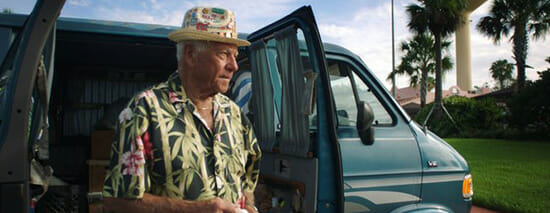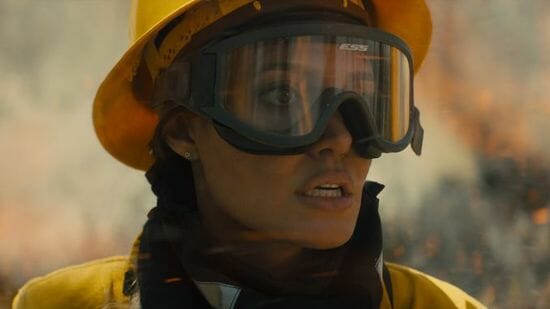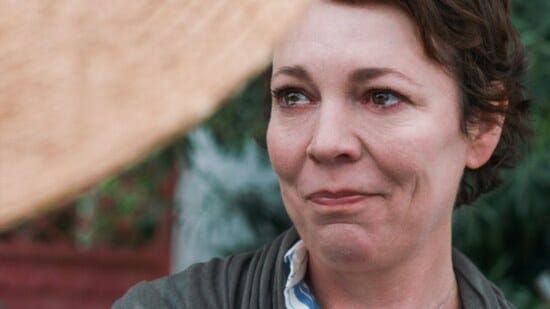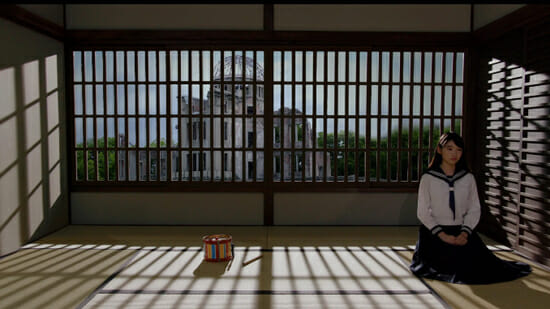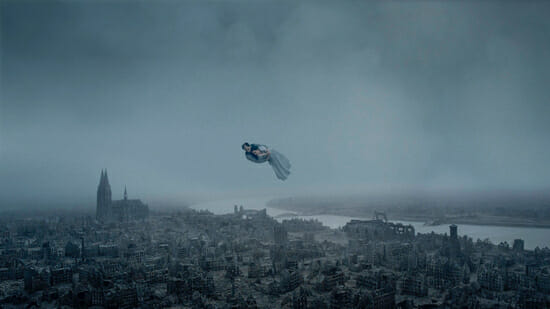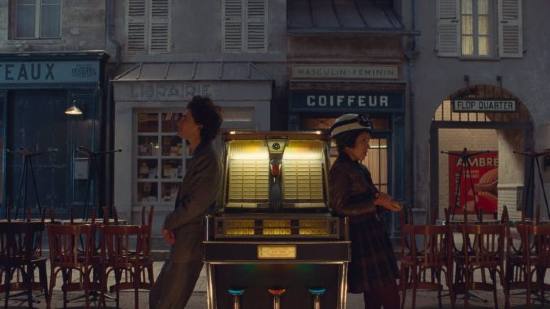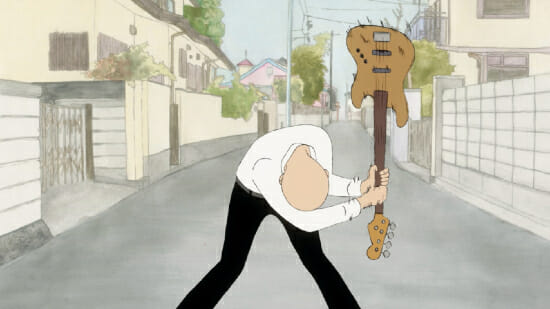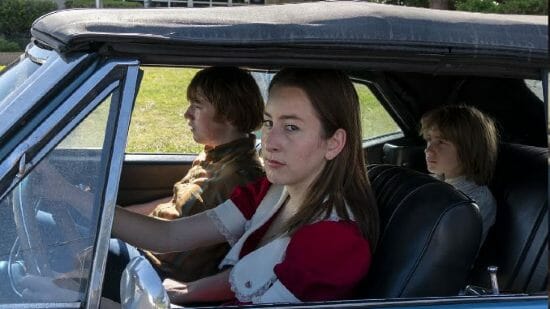
Remember 2020? When movie theaters shut down and everyone had a nice long think about what it meant for the Future of Movies? When HBO Max’s gamble to release every Warner Bros. movie on streaming at the same time as in theaters shocked the industry? Unfortunately, if you remember all that, you also have a pretty good handle on 2021. The main change is that instead of a sharp fear for our health and industry, we have a deadened and numbed resignation that things are just pretty tough—and, as we’ve seen with theatrical attendance ebbing and flowing alongside coronavirus spikes/variants, they will be until we agree to take the pandemic seriously. Our main solace, though, is that the movies have been incredible and more widely available than ever.
2021 renewed debates around theatrical-only debuts for all but the Spider-Manliest of blockbusters (superheroes counted for four of the top five box office spots—all of them, if you agree with me that the Toretto clan are effectively comic book characters), but it also allowed people to catch everything from miniscule documentaries to a new Matrix from the comfort/safety of their living rooms on streamers broad and niche. We were flooded with memes, as movies like Dune inspired an audience that was often more captive than usual and increasingly choosing to watch new releases at home. Did people watch more movies this year? Hard to say. Did they talk about movies more this year? It sure feels like it.
And they thankfully had some great films to discuss: Not only did we get exciting releases from American masters, but many festival and international films from the past few years finally made their way stateside now that theaters were open. It was a year of freaky mothers (of car babies, lamb babies, baby Annettes), reverend mothers (Charlotte Rampling, in both Dune and Benedetta), tiny mothers (Petite Maman) and parallel mothers (Parallel Mothers). It was a year of franchise entries screwing with intertextuality, for better (The Matrix Resurrections) or worse (Space Jam: A New Legacy). It was a year of strong, slow cinema and a year of the trashiest fast-fashion fodder you could imagine. It was a year of musicals. The variety was there, if people wanted to look for it. And if 2021 had anything going for it, people had more time and ability to look than ever. We certainly did. So please, using what we found, support great filmmakers and a great industry in the midst of its metamorphosis.
Here are the 50 best movies of 2021:
50. Petite Maman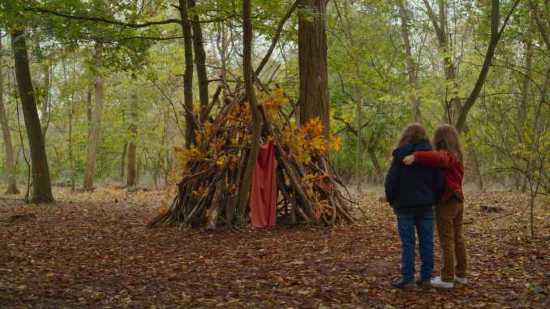
A year or two ago, I asked my mom whether she feels like her age, or if she feels younger. I told her that I still don’t feel like I’m an adult, that I feel like a teenager disguised as a person in their mid-twenties. I wanted to know if my mom had ever felt this feeling, and if she had, if it ever goes away—if people ever reach a point where they know that they’ve finally, officially stepped into adulthood and shed their adolescence. She admitted that sometimes she does feel like she ought to: Like a woman in her early sixties. But most of the time, in every way that isn’t physical, she still feels like a kid. In Petite Maman, Céline Sciamma’s follow-up to 2019’s Portrait of a Lady on Fire, the French director returns with a much smaller affair by comparison: A compact, 73-minute (yet nonetheless affecting) portrait of grief, parenthood and the constant dialogue between our past and present selves. Following the death of her maternal grandmother, eight-year-old Nelly (Joséphine Sanz) travels with her parents (Nina Meurisse and Stéphane Varupenne) to her mother’s childhood home. By all accounts, little Nelly seems to get on well with her mother. During the journey from the nursing home, Nelly attentively feeds her grieving parent cheese puffs and apple juice from behind the driver’s seat, then slides her tiny arms around her mother’s neck in an embrace to comfort her as she steers the wheel. But grief is a concept largely foreign to a child wise beyond her years and eager to play pretend as an adult, yet still distant to the reality of death. In the wake of her grandmother’s passing, as her mother clears out her old family things from the house, Nelly laments with more annoyance than anything that she bid a farewell to her relative that wasn’t the right kind of goodbye. She would have given her a better goodbye if she had known it would be her grandmother’s last. “We can’t know,” her mother tells her, and the two of them fall asleep wrapped in each other’s arms. But when Nelly awakes the next morning, her mother is gone. It’s a discovery less crushingly felt due to an implied absence that Nelly is familiar with. And her spacy yet well-meaning father can’t give Nelly a straight answer as to where her mother has up and left, but he doesn’t seem too concerned about it. The grieving process is something he’s acquainted with, but something he’s reluctant to impart upon a young kid. So, Nelly, an only child, goes off to play in the woods by herself to occupy her time during this confusing interlude. It’s there in the wilderness behind her mother’s old house that Nelly discovers a little girl about her height, about her same hair color and face shape, who lives in a home exactly like the one just beyond the path in the woods where Nelly came from. A little girl named Marion (unsurprisingly, Joséphine’s twin sister, Gabrielle Sanz) who’s building a branch fort in the woods; the same branch fort that Nelly’s mother had once made when she was around Nelly’s age. With a gentle touch, Sciamma crafts a profound, easily digestible film that takes heavy themes and makes them bite-sized. She looks at the way we speak to one another, and to ourselves, at every age, and how these conversations are inevitably dulled in the schism between a child and their parent. Our parents only know one sliver of our own personhood just as time has robbed us of knowing our parents, their proximity to changing our diapers and teaching us to drive stunted by the lives we create as we become our own people, and as we grow to understand that our parents are people, too. Petite Maman is about this dialogue we create with our families that is just as meaningful, if often frustrating, amidst the fractures inherent to our relationship with them.—Brianna Zigler
49. The Beta Test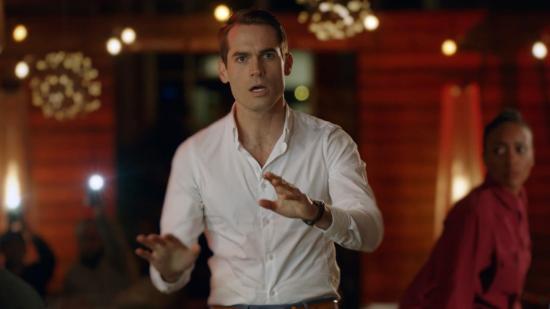
Jim Cummings tends to play men who refuse to lose control. His characters feel similar, but then so do many white, cisgender, heterosexual, elder millennial men—unable to wield power over their domain, they flail belligerently through these, their End Times. They find closure in slapping around a corpse (Thunder Road), or they turn to folklore and cryptozoology to explain a world they no longer understand at all (The Wolf of Snow Hollow). Everything is terrifying, everyone is watching, and the least noble thing any of them can do as the teeth rot from their mouths is rage against a universe that no longer wants them. So that’s what they do. In The Beta Test, his first feature with co-director/-writer PJ McCabe, Cummings is Jordan Hines, a Hollywood agent facing extinction. As talent agencies battle the Writers Guild of America over “packaging deals” and his whole career’s culture shifts out from under him, Jordan receives a handsome purple invitation in the mail promising a “no-strings attached sexual encounter with an admirer at The Royal Hotel.” His marriage to Caroline (Virginia Newcomb) looms—as do all things in the white millennial man’s life—and, as he’s fit and attractive and not uncommonly met by temptation in public, he can’t help but fantasize about whatever validation the purple letter offers. Are his fantasies even “OK” anymore? Why does no one seem to care when Raymond (Wilky Lau), a potential big international client, aggressively grabs Jordan’s crotch at a party? A white millennial man cornered by obsolescence—or worse, an obsolescence no one gives much of a shit about—will scratch and whine for scraps of satisfaction. Just any iota that someone gives about what he wants—that he matters. As an excoriation of masculinity, there isn’t much to The Beta Test that Cummings hasn’t explored before, and the long takes and bravura monologues that initially defined his voice as a filmmaker appear here, though more sublimated into the fabric of the film than in any previous feature. And his handle on genre remains deft but slippery. The Beta Test is an erotic thriller as devotedly as it’s a satire and an upsetting glimpse of a very specific dying breed of tinseltown phony. Which is much funnier than it sounds. Because everyone is watching and everything is terrifying. The Beta Test never attempts to refute how lame Jordan is, how ineffectually he inhabits this plane of existence, how much of a baby he is, how unhelpful he will be as the planet devolves into the kind of chaos where violence and oblivion just occur in the background. The film just celebrates Jordan’s delusions as exactly what they are: The only way to cope with a universe that no longer wants people like him around anymore.—Dom Sinacola
From its intricate and exciting swordplay to its detailed depiction of styles and cultures underutilized by the House of Mouse, Raya and the Last Dragon is one of Disney’s better action-adventures. Its first foray into a Southeast Asian environment blends its traditional “princess” movies with a trial-hopping quest like Kubo and the Two Strings. Raya (Kelly Marie Tran), after a youthful tragedy leaves her father (Daniel Dae Kim) turned to stone and her land fractured, must hop from community to community—gathering up the pieces of a magical gem and new quirky team members—so that Sisu (Awkwafina), the last dragon, can depetrify everyone and put the world right. There’s a well-meaning but sloppily implemented lesson from writers Qui Nguyen and Adele Lim about trust at the film’s heart, explained almost like an argument for nuclear disarmament—basically, mutual animosity won’t improve if nobody’s willing to take the first step. But it’s all just an excuse really, to take us through some of the best environmental work of Disney’s 3D era and some of its best fight sequences ever. A muddled but bold finale keeps Raya from being a tour de force, but it’s still worth taking a tour through Kumandra.—Jacob Oller
47. Flee
“Flee.” It’s an imperative, a one-word title telling the audience what a person has to do to save themselves from cultural takeover by barbarians with too many guns: Get the hell out of Dodge. Run for your lives. Flee. Danish documentarian Jonas Poher Rasmussen’s new movie animates the truth of one man, Amin, Rasmussen’s friend, who for the first time in his adult life (and in his relationship with Rasmussen) has decided to open up about the time he and his family cut town when the Taliban took over Kabul. Being an everyday non-fundamentalist person in Afghanistan is hard enough with those lunatics in control. Being both everyday and non-fundamentalist and a closeted young gay man is worse. And that unavoidable bleakness softens and sharpens through the film’s presentation. Using animation to reenact Amin’s perilous journey from Afghanistan to Denmark, with stops along the way in Russia and Estonia, Rasmussen has a way of layering the stunning cruelty Amin endures and observes on the road to safety with an electric playfulness: Even the worst real-life images gain a certain exuberance when recreated by hand. But the film comprises Amin’s recollections, and human memory being what it is—simultaneously faithful, fuzzy and faulty—the casual alchemical qualities so intrinsic to animation as a medium pull those recollections into harsh relief. Maybe this is the only way Amin can face his past. Animation also has a way of feeling more alive than live-action, or alive in its own separate way, which makes Flee’s darkness all the darker. Most of all, Rasmussen is letting Amin tell his story his way. Animation only ultimately acts as a veneer. Even through the layers of artifice, what this movie shows us may be one of cinema’s most harrowing refugee stories.—Andy Crump
46. Come True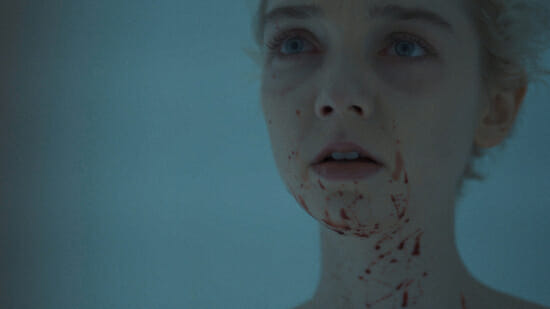
Come True, Anthony Scott Burns’ horror first, sci-fi second hybrid film essentially dramatizes what filmmaker Rodney Ascher gets at in his 2015 sleep paralysis documentary The Nightmare. What if your worst fears manifested in the real world? What if you couldn’t tell the difference between the land of the waking and the realm of the slumbering? What if the difference doesn’t even matter because, whether the nightmares are real or not, they still smother you and deny you rest, respite and sanity? Conceptually, the movie is frightening. In more practical terms it’s deeply unsettling, a terrific, sharply made exercise in layering one kind of dread on top of another. “Don’t you ever feel like you’re seeing something that you’re not supposed to?” Sarah (Julia Sarah Stone) asks Riff (Landon Liboiron), the scruffy Daniel Radcliffe stand-in conducting an ill-advised science experiment masquerading as a sleep study. The ever-present unnerving sensation that follows—that unspeakable terror is hovering over your shoulder—puts the film in close company with It Follows, another movie about disaffected youth on the run from evil they don’t understand and can’t fight. It’s contemporary, atmospheric and cuts deep—and more than that, it’s original. Burns conjures horror so vivid and tactile that at any time it feels like it might leap off of the screen and into our own imaginations or, worse, our own lives.—Andy Crump
Bubble worlds and echo chambers, escapism and selectivity—perhaps the reason that first-time director Lance Oppenheim seems to understand The Villages retirement community so deeply is because its social elements resonate with anyone that grew up online. These social phenomena are, of course, not new, but they are a vital part of everyday life—political and otherwise—in a digital landscape. Approaching them and those that willingly seek them with open eyes and ears, but with brains enough to assess their motives, takes a savvy non-fiction storyteller. Oppenheim’s new documentary, Some Kind of Heaven, introduces the filmmaker as an exciting new voice as he unpacks the quintessential “got old and went to Florida” locale with visual beauty, deep empathy and the wizened charisma of its subjects. Built from his college thesis project, Some Kind of Heaven is a confident debut that follows a handful of Villagers: Anne and Reggie, a couple with a husband that’s used retirement to experiment with drugs and embrace ideas (like that he actually died and has been reincarnated) that estrange him from his extremely patient wife; Barbara, a full-time working widow stranded in a place that rubs her the wrong way; and Dennis, a con man living in his van on the prowl for a wealthy single woman to provide him a place in The Villages. Immediately, that supposed sense of uniformity—that designed sameness of aesthetic and experience that helped give The Villages its reputation as “Disney World for old people”—is revealed to be nothing but a front. And that’s before you really even start to meet the subjects. The film’s opening juxtaposes a diverse selection of primary-colored synchronized activities (swimming, golf carting, rowing) with voiceover that lays out the hyper-positive, hyper-choreographed façade that comes with living in the community. The Villages create the same kind of “see no evil” bubble that resembles the positivity-only fronts put on by internet personalities looking to create their own echo chambery cults. Unraveled here, it’s somewhere between Errol Morris’s loving look at eccentric Americana and a John Waters wet dream: Hawaiian shirts, polyester, tanned wrinkly skin, souped-up golf carts and elderly cheerleaders. These striking visuals continue throughout the film, with editing by Daniel Garber that transcends its (still slick) match cuts to a more elegant place of narrative flow between images. And Oppenheim knows just where to place everything. Cinematographer David Bolen’s framing centers and grounds its subjects when everything around them is designed to be a heightened escape from the inevitable reason they all came there: To die happy. Some Kind of Heaven leaves its subjects’ stories without ends—except the one end everyone knows is coming for us all—basking in the beautiful imperfect potential of an open door, an empty calendar day, a bare dance floor.—Jacob Oller
The Sparks Brothers is a thorough and charming assessment and appreciation of an idiosyncratic band, and the highest praise you could give it is that it shares a sensibility with its inimitable musicians. Not an easy task when it comes to Ron and Russell Mael. The Californian brothers have been running Sparks since the late ’60s (yeah, the ’60s), blistering through genres as quickly as their lyrics make and discard jokes. Glam rock, disco, electronic pioneering—and even when they dip into the most experimental and orchestral corners of their musical interests, they maintain a steady power-pop genius bolstered by Russell’s fluty pipes and Ron’s catchy keys. It’s here, in Sparks’ incredible range yet solidified personality, that you quickly start to understand that The Sparks Brothers is the marriage of two perfect subjects that share a mission. Experts in one art form that are interested in each others’, Ron and Russell bond with director Edgar Wright over a wry desire to have their fun-poking and make it art too. One made a trilogy of parodies that stands atop its individual genres (zombie, cop, sci-fi movies). The others made subversive songs like “Music That You Can Dance To” that manage to match (and often overtake) the very bops they razz. Their powers combined, The Sparks Brothers becomes a music doc that’s self-aware and deeply earnest. Slapstick, with a wide range of old film clips delivering the punches and pratfalls, and visual gags take the piss out of its impressive talking heads whenever they drop a groaner music doc cliché. “Pushing the envelope?” Expect to see a postal tug-of-war between the Maels. This sense of humor, appreciating the dumbest low-hanging fruit and the highest brow reference, comes from the brothers’ admiration of seriously unserious French filmmakers like Jacques Tati (with whom Sparks almost made a film; remember, they love movies) and of a particularly formative affinity for British music. It doesn’t entirely tear down facades, as even Wright’s most personal works still emote through a protective shell of physical comedy and references, but you get a sense of the Maels as workers, brothers, artists and humans on terms that they’re comfortable with. The nearly two-and-a-half-hour film is an epic, there’s no denying that. You won’t need another Sparks film after this one. Yet it’s less an end-all-be-all biography than an invitation, beckoning newcomers and longtime listeners alike through its complete understanding of and adoration for its subjects.—Jacob Oller
There are few things about a thriller that get me more excited than realizing the movie doesn’t rely on complicated plot MacGuffins, but on a fully realized setting and characters that either make their home or find themselves helpless there. From writer/director Taylor Sheridan, Those Who Wish Me Dead is one of those thrillers—and those two elements, setting and character, are two that Sheridan is most capable with. Based on Michael Koryta’s 2014 novel of the same name, the film’s rock-solid survival story is enhanced by its charming ensemble and striking, elegant environment. This simplified adaptation (which Koryta co-wrote with Sheridan alongside Charles Leavitt) thrusts good and evil together with the same easy confidence of a corral shootout. A forensic accountant (Jake Weber, playing a pretty badass accountant but not a The Accountant-level badass) and his son, Connor (Finn Little) are on the run. Why? Well, the most we get is that Connor’s dad found out something pretty damn incriminating and those incriminated are none too happy. “What did you do?” Connor asks. All he really gets by way of answer is, “The right thing.” Quickly, that hard ol’ reality sets in that the right thing might not be the consequence-free thing it’s cracked up to be. It’s all carried by its cast, and Angelina Jolie is its best member. She plays Hannah, whom Connor stumbles into in the middle of the forest after Plan A is jettisoned for B. A smokejumper (basically like if a regular firefighter was in Point Break) with PTSD, Hannah was left guilt-ridden and shaken after a particularly awful wildfire. It also left her stuck in a dead-end assignment: All alone on watch duty, high above the forest in an isolated fire tower. Among the other visual feats pulled off by Ben Richardson (Sheridan’s cinematographer on Wind River and Yellowstone, who recently helped Mare of Easttown “[render] our small, collective suffering in stark shapes”) is the height, lonesomeness and awe of this skyward sentry, far above the verdant treetops. Ensembles collide, ricochet and tangle as Those Who Wish Me Dead builds its brutal if expected thrills, and it’s near impossible to look away. It’s the dense woodland, the savvy character work, the moral core that’s both optimistic and pessimistic enough to sustain its modern-day white and black hats. It pulls off the kind of complexity and aesthetic cohesion that Without Remorse and Sicario: Day of the Soldado (Sheridan’s latest screenplay works) so sorely lack. Gripping and intelligent, Those Who Wish Me Dead is revitalizing.—Jacob Oller
42. The Dig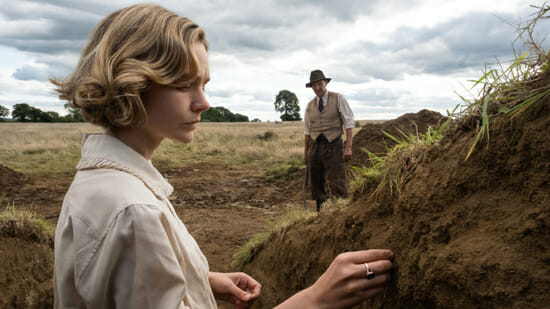
There are many reasons The Dig might have piqued initial interest: First, it stars Carey Mulligan, Ralph Fiennes and a fine cast of other notable actors; second, you could tell from the trailer that this is one of those British films, a period piece filled with silences and restraint; and finally, it’s based on a real-life historical event, the excavation and discovery of the Sutton Hoo site (an Anglo-Saxon burial ground) in Suffolk in 1939. Those were the reasons I’d decided to watch The Dig as soon as I saw the first windswept image of Mulligan, looking both determined and grim, much before I saw the trailer. But soon after I had settled into the couch, I found myself gradually immersed in the slow lyricism of the film. Right from the opening frame—which shows Fiennes sat on a rowboat, being ferried with his bicycle across a river; oars gently pulling through the lapping waters, birds in the sky, golden hour in the horizon—I could sense myself coming to a still. It felt like a balm. The Dig tells the story of Edith Pretty (Mulligan), landowner and widowed mother, who employs Basil Brown (Fiennes), a self-taught excavator/archaeologist, to dig up the large mounds of earth on her Sutton Hoo property. When Brown asks Pretty why she didn’t go through the usual route of contacting a museum, Pretty replies that she did, but the impending second World War means that resources are scant, and Brown was the best bet—even though he has been described as a challenging man, with unorthodox ideas. The war looming in the background adds a measure of urgency to the otherwise unhurried pace of the film. The drama lies within the interactions between these people who have come together for the project: Pretty and Brown, the team of experts from the British Museum headed by Charles Phillips (Ken Stott) and including Stuart (Ben Chaplin) and Margaret Piggot (Lily James), Pretty’s cousin Rory Lomax (Johnny Flynn) and Brown’s wife May (Monica Dolan). As the archaeological team digs deeper, they also unearth emotions and motivations within themselves and those around them. Stott is delightfully annoying as the overbearing British Museum veteran, sneering at Brown’s lack of credentials and spluttering when put in his place by Pretty. James is endearingly conflicted as a young wife and junior archaeologist, trying to find her place in her marriage and the work field—even in her attraction to the roguish Rory. The film beautifully brings the account of the people behind one of England’s most famous archaeological events to life. Even if there have been some artistic licenses taken, I know that when I go to the British Museum next—in the near future, one hopes—I will be making a beeline for the Sutton Hoo exhibit.—Aparita Bhandari
41. Delphine’s prayers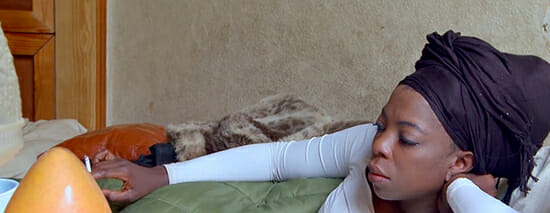
When we meet Delphine, though she’s in her early 30s and looks even younger, it feels as if she’s in the middle of her life too. In long monologues, punctuated by practiced puffs of one cigarette after another—lit by the film’s throughline, a bright orange lighter—she tells us who she is. Delphine’s prayers takes place in one room in one apartment, but it begins in poverty in Cameroon, director Rosine Mbakam’s storyteller stumbling in and out of pidgin, then French, then pidgin again, all depending on where the narrative takes her. Though Mbakam’s camera, and Mbakam herself, never leave Delphine’s cluttered Belgian flat, every moment is compelling. Delphine is a natural, and she seems to know that. She uses it, works with it—has earned it—and that influence extends to the director. If anything Delphine tells us is exaggerated, we understand the truth beneath the embellishment; if anything she tells Mbakam is fabricated, Mbakam at the very least appreciates how much the fabrication keeps Delphine’s story moving. From the first moments of Delphine’s prayers we can gather that Mbakam is old friends with Delphine, but eventually learn that they didn’t meet until they were both African immigrants in Europe. Otherwise, they would have never crossed paths at home in Cameroon, hailing from different social strata. Belgium equalizes them. There they are both outsiders, and that is all they are to many. Delphine describes becoming a sex worker at age 14 to make money for her family, then marrying a European to continue supporting her family and moving to Belgium, but still needing to turn tricks now and then despite her husband’s income—their marriage clearly loveless and her body still at the mercy of white sexual colonization. Then Delphine breaks into full-on religious invocation in the film’s final moments, breathless as she finally lets herself be vulnerable, begging for forgiveness. She must have done something to deserve this life. She’s sorry.—Dom Sinacola
40. The Mitchells vs. the Machines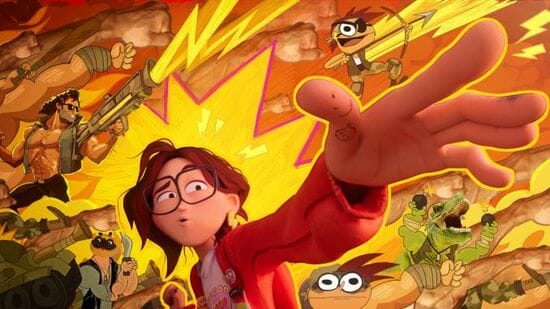
Animated generational divides have never been more like a sci-fi carnival than in The Mitchells vs. the Machines. Writer/director Mike Rianda’s feature debut (he and co-writer/director Jeff Rowe made their bones on the excellently spooky, silly show Gravity Falls) is equal parts absurd, endearing and terrifying. It’s easy to feel as lost or overwhelmed by the flashing lights and exhilarating sights as the central family fighting on one side of the title’s grudge match, but it’s equally easy to come away with the exhausted glee of a long, weary theme park outing’s aftermath. Its genre-embedded family bursts through every messy, jam-packed frame like they’re trying to escape (they often are), and in the process create the most energetic, endearing animated comedy so far this year. And its premise begins so humbly. Filmmaker and animator Katie (Abbi Jacobson) is leaving home for college and, to get there, has to go on a road trip with her family: Rick (Danny McBride), her Luddite outdoorsy dad; Linda (Maya Rudolph), her peacemaking mom; and Aaron (Rianda), her dino-freak little brother. You might be able to guess that Katie and her dad don’t always see eye-to-eye, even when Katie’s eyes aren’t glued to her phone or laptop. That technocriticism, where “screen time” is a dirty phrase and the stick-shifting, cabin-building father figure wants his family to experience the real world, could be as hacky as the twelfth season of a Tim Allen sitcom. The Mitchells vs. the Machines escapes that danger not only through some intentional nuance in its writing, but also some big ol’ anti-nuance: Partway through the trip, the evil tech companies screw up and phone-grown robots decide to shoot all the humans into space. This movie needed something this narratively large to support its gloriously kitchen-sink visuals. The Sony film uses some of the same tech that made Spider-Man: Into the Spiderverse look so crisp and unique, adding comicky shading to its expressive CG. In fact, once some of the more freaky setpieces take off, you wouldn’t be surprised to see Miles Morales swing in to save the day. The Mitchells vs. the Machines’ spin on the Spidey aesthetic comes from meme and movie-obsessed Katie, whose imagination often breaks through into the real world and whose bizarre, neon and filter-ridden sketchbook doodles ornament the film’s already exciting palette with explosive oddity. This unique and savvy style meshes well with The Mitchells vs. the Machines’ wonderfully timed slapstick, crashing and smashing with an unexpected violence, balanced out with one truly dorky pug and plenty of visual asides poking fun at whatever happens to be going on.—Jacob Oller
39. Judas and the Black Messiah
“Not all skinfolks are kinfolks” is an idiom used colloquially among Black people to address the fact that although they share a racial identity and corresponding experiences of racism, intracommunal ideas regarding the path to Black liberation are seldom synchronous. Furthermore, white supremacy’s propagation of capitalist individualism as the default social framework positions Black collective action as an inherent threat to the United States of America. Director Shaka King centers all these tensions in his brilliant film Judas and the Black Messiah, a historical drama tinged with dazzling shades of caramel and crimson that documents the FBI’s calculated assassination of noted Black Panther Fred Hampton (Daniel Kaluuya). When car thief Bill O’Neal (LaKeith Stanfield) is caught impersonating a federal officer, FBI agent Roy Mitchell (Jesse Plemons) offers him an ultimatum: If O’Neal helps the Feds infiltrate the Black Panther Party and offers intel on their tactics, he can evade a substantial prison sentence and be handsomely compensated for his cooperation. As O’Neal immerses himself into the world of the Black Panthers, his commitment to his own self-interest is pressured by the Panthers’ communitarianism and radical politics. Judas and the Black Messiah superbly centralizes the betrayal of the informant’s Judas figure as he operates as a nexus between the Panthers and J. Edgar Hoover (Martin Sheen)’s FBI, while also amplifying the experiences of the messianic Hampton and his fellow prominent Panthers portrayed by the film’s impressive ensemble cast. While I would love to see Kaluuya take on a leading role in which he at no point has to fight for his life (Get Out, Widows, Black Panther, Queen & Slim) he is an exemplary Fred Hampton. EX-EM-PLA-RY. From the head tilt to the Chicagoan cadence to the emotive gaze, Kaluuya manages to embody Hampton’s physicality and voice without falling into the trap of pure mimicry or impressionism. This is no small achievement especially considering the dearth of Hampton’s fictionalized portrayals. On the other side of things, Stanfield sinks into O’Neal’s paranoia and shivering soul in a way that simultaneously prompts reasonable disgust towards the character and intermittent bouts of empathy. Understanding that Black liberation can not move at the speed of white supremacist comfort is the price of mental and emotional admission to this film. As it should be. Judas and the Black Messiah remarkably fashions a world in which O’Neal’s behaviors are contextualized through the ethos of America’s institutions, and one where the efforts of Hampton and the Panthers are given abundant space to be boldly witnessed.—Adesola Thomas
Kenny G is aware that he’s less a personality to people than he is a sound. And that sound might be as divisive as sounds get, having at once made the 65-year-old a preposterously rich man and a decades-long cultural punching bag. Listening to Kenny G, a new documentary from Hail Satan?’s Penny Lane (and serving as part of HBO’s Music Box docuseries), sets out to finally untangle the man from the meme. But as it becomes clear that the two are quite happily fused together, the edges having been smoothed out a long time ago, she’s forced to take the whole curly-haired mass seriously instead. However convincing a pair Kenny G and his instrument make, we learn early in Lane’s film that what he’s truly horny for is the idea of craft. He’s meticulous in the studio, figuratively hacking at his audio files until they’re to his liking. But his choice of instrument—that he plays one in the first place, even—seems almost beside the point. “I don’t know if I love music that much,” he admits. More than anything, he’s a collector of skills, obsessed with the idea that you can master anything via practice and persistence—by “putting in the reps.” But the star’s overall ambivalence re: music is part of what makes Kenny G a frustrating figure for jazz critics and scholars, who make up the majority of Lane’s interview subjects. Another issue is that jazz comes from a rich musical tradition, one that the star doesn’t seem all that interested in. Though it’s a historically conversational genre, for instance, Kenny G acts as both caller and responder in his work. But jazz is also inextricable from Black American culture, a topic to which Lane devotes a significant chunk of the film, careful to not rush the discussion. Kenny G admits that he doesn’t give much thought to his own race, but, pressed by Lane, doesn’t take any convincing to agree that his whiteness was crucial to his commercial success in the jazz space. Like the film in general, the moment feels entirely earnest; you can practically see the cogs turning in real time. Perhaps a person as genuinely invested in self-improvement as this is also, to some extent, uncancellable as a public figure. The star’s perfectionism makes the film fascinatingly self-reflexive. “I think that people like celebrities that get the joke,” he says. “Like, I get the joke.” —Sydney Urbanek
37. Plan B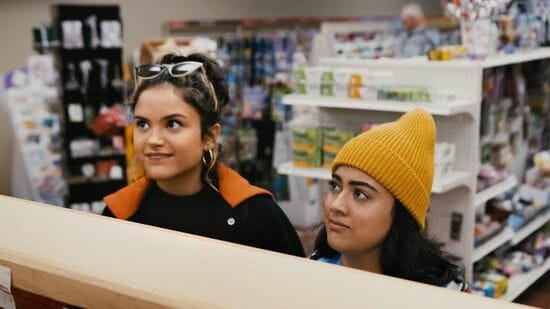
The meeting of past and present is on full display in Plan B which puts a new spin on one of the tried and true plots of the genre—the road trip. Sunny (Kuhoo Verma) is a responsible student trying to do everything right. Her best friend Lupe (Victoria Moroles) seems to walk more on the wild side, but it’s really just bravado hiding some inner insecurity. When Sunny’s mom Rosie (Jolly Abraham) goes out of town for a real estate convention, Lupe convinces Sunny to throw a party to get the attention of Hunter (Michael Provost). “Who plays hockey in a cardigan? He’s like an athletic librarian,” Sunny sighs. But after one too many shots of some very questionable alcoholic punch (pickle juice is involved), Sunny has sex for the first time with the super religious and super geeky Kyle (Mason Cook from the late, great TV series Speechless). The next morning, to her horror, Sunny discovers the condom and its contents have been inside her all night long. The quest for the Plan B pill begins. All films require a willing suspension of disbelief and Plan B does need its viewers to not ask too many questions. Suffice to say a lot of Sunny and Lupe’s problems could have been solved by a simple Google search on their phones. But once you set aside any lingering doubts, the movie is a delight. That’s in large part due to first-time director Natalie Morales. Morales, known for her roles on Parks & Recreation, The Middleman and Dead to Me, clearly understands these characters and the emotional angst of high school. Perhaps because Morales is an actress herself, she’s even more conscious of ensuring that the female leads are treated with the respect they deserve.—Amy Amatangelo
36. Bergman Island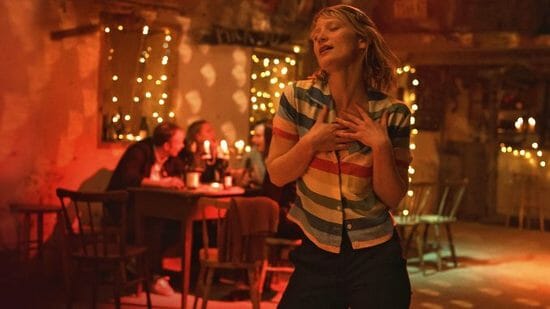
There is no place on Earth tied more firmly to a filmmaker than Fårö is to Ingmar Bergman. One cannot venture through the small island without being reminded of him at every turn: The rugged, ominous seascape that lurks in the background of Persona (1966); the carcass of a farmhouse that was burned down during the filming of Shame (1968); the seafront estate that the director called home for 40 years. And, of course, there’s the house where Scenes from a Marriage (1973), Bergman’s wildly popular and subversive marital drama, was filmed. That’s where Chris (Vicky Krieps) and Tony (Tim Roth) plant themselves at the start of Mia Hansen-Løve’s Bergman Island. The couple, both writers and directors, are participating in an artist’s retreat to see if being in the shadow of the Swedish filmmaking giant will help get their creative juices flowing. What begins as a straightforward story of two artists creating different projects ultimately turns into Hansen-Løve’s strongest argument for the inextricable nature of life and art yet. On both personal and artistic levels, Chris and Tony are besieged by Bergman’s ghost the moment they set foot on the island. The woman who shows the couple into their house, for example, makes sure to give them the dismal news that Scenes from a Marriage was responsible for a huge uptick in divorce rates upon its release. Still, the couple just can’t seem to hold back from persistently discussing the filmmaker’s achievements, and fighting over which of his films to watch on the island. (Anything but The Seventh Seal, of course, which Tony hates). But what’s so satisfying about Bergman Island is that it ultimately defies all personal and creative expectations placed on it by its association with Fårö. While on Fårö, Chris begins to dream up an idea for a new film, inspired by her own first love. As she narrates to Tony, the film comes to life: A young woman named Amy (Mia Wasikowska) arrives at Fårö for a wedding and is reunited with her old lover Joseph (Anders Danielsen Lie). Bergman Island’s film-within-a-film is an explosive reflection of Chris’s inner state as an artist. Amy and Joseph’s story is gracefully imbued with possibility, only furthered by Wasikowska’s tender, emotional performance. Their B-plot is told with the same nimble vigor as Chris and Tony’s story, but with more of a breezy, unrestrained edge. Amy dances to ABBA and skinny dips at night. Nothing feels forced about the two narratives: They are perfectly woven together both by Hansen-Løve’s subdued, effortless directorial style and Marion Monnier’s artful editing, until each feels like it could not exist without the other. When the two storylines melt into abstraction, it feels perfectly organic. Hansen-Løve’s films have always had such a strong overtone of humanity, with a deep focus on emotions and characters unafraid to wear their hearts on their sleeves, that it only makes sense that her final statement in Bergman Island is that being an artist is a deeply, deeply personal thing. With the backdrop of Bergman, the film suggests that, additionally, it’s a powerful thing to be inspired by an artist. But what’s even more fulfilling is to be inspired by an artist and still reject their methods of creation in favor of your own.—Aurora Amidon
35. The Paper Tigers
When you’re a martial artist and your master dies under mysterious circumstances, you avenge their death. It’s what you do. It doesn’t matter if you’re a young man or if you’re firmly living that middle-aged life. Your teacher’s suspicious passing can’t go unanswered. So you grab your fellow disciples, put on your knee brace, pack a jar of IcyHot and a few Ibuprofen, and you put your nose to the ground looking for clues and for the culprit, even as your soft, sapped muscles cry out for a breather. That’s The Paper Tigers in short, a martial arts film from Bao Tran about the distance put between three men and their past glories by the rigors of their 40s. It’s about good old fashioned ass-whooping too, because a martial arts movie without ass-whoopings isn’t much of a movie at all. But Tran balances the meat of the genre (fight scenes) with potatoes (drama) plus a healthy dollop of spice (comedy), to similar effect as Stephen Chow in his own kung fu pastiches, a la Kung Fu Hustle and Shaolin Soccer, the latter being The Paper Tigers’ spiritual kin. Tran’s use of close-up cuts in his fight scenes helps give every punch and kick real impact. Amazing how showing the actor’s reactions to taking a fist to the face suddenly gives the action feeling and gravity, which in turn give the movie meaning to buttress its crowd-pleasing qualities. We need more movies like The Paper Tigers, movies that understand the joy of a well-orchestrated fight (and for that matter how to orchestrate a fight well), that celebrate the “art” in “martial arts” and that know how to make a bum knee into a killer running gag. The realness Tran weaves into his story is welcome, but the smart filmmaking is what makes The Paper Tigers a delight from start to finish.—Andy Crump
34. Moffie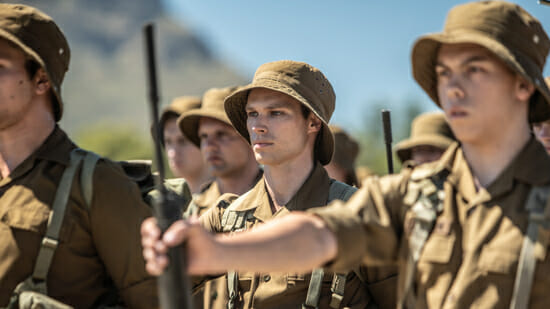
“Moffie” is an Afrikaans slur, used to describe a gay man. For those of us who haven’t grown up hearing it, the term can read almost affectionate, its soft syllables suggesting a sweetness. In reality, there’s violence in the word, spat out with cruelty. This tension pervades the fourth film from Oliver Hermanus, regarded as one of South Africa’s most prominent queer directors. Moffie tells the story of Nicholas Van der Swart (Kai Luke Brümmer), a closeted 18-year-old drafted into his mandatory military service in South Africa in 1981, when the country was still in the throes of apartheid. Adapted from André Carl van de Merwe’s novel, Moffie tells a brutal tale with moments of beautiful respite. Despite the constant barrage of terrorizing drills and frat boy behavior, however, there is tenderness—like Nicholas’ connection with his rebellious squadmate, Dylan Stassen (Ryan De Villiers). An earlier incident makes it abundantly clear how dangerous it is to express any sort of affection. As a result, even the smallest gesture of intimacy is fraught with tension. Although the young men, shown in various forms of dress and undress, are strapping soldiers, there’s also a vulnerability to them. You can’t help but silently cheer, even as your heart breaks a little, when Nicholas and Michael break into a muted rendition of “Sugarman,” giggling as they clean their rifles. Despite the army’s best efforts to break the young men, their spirits seem to survive. Despite the heavy load it carries, Moffie is a masterful film. Hermanus and Jack Sidey have co-written a tight script, with stretches of silences that pull you into the internal struggles of its characters. The cinematography by Jamie D Ramsay ranges from languorous shots of the rugged, dusty landscapes where the recruits carry out drills in the harsh sun to the handheld immediacy of Nicholas and his fellow soldiers’ misery. The cast—made up of a mix of high school students, trained actors and non-professionals—manages to conjure up a chapter of South African history that many would like to forget.—Aparita Bhandari
33. Undine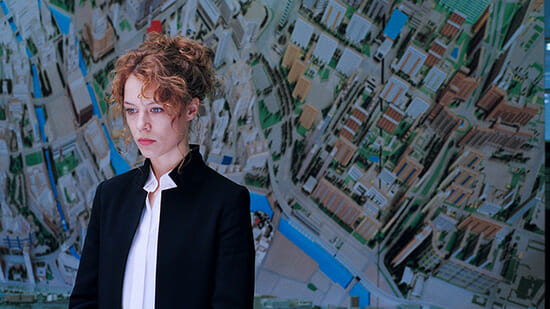
Undine opens as a rom-com might. A lilting piano score, not without a shade of sadness, purrs quietly during the title cards. A tearful break-up presages a quirky meet-cute between industrial diver Christoph (Franz Rogowski) and city historian Undine (Paula Beer), our new couple bound by the irrevocable forces of chance—and, in director Christian Petzold’s own mannered way, a bit of physical comedy—as the universe clearly arranges for the pieces of their lives to come together. Squint and you could maybe mistake these opening moments for a Lifetime movie—that is, until the break-up ends with Undine warning her soon-to-be-ex (Jacob Matschenz) that she’s going to have to kill him. He doesn’t take Undine seriously, but the audience can’t be so sure. Beer’s face contains subtle multitudes. She could actually murder this guy. What once felt familiar now feels pregnant with dread. And that’s saying nothing about Christoph’s odds for survival. Anyone remotely familiar with the “Undine” tale knows that she’s not lying to her ex. Undine is a water spirit, making covenants with men on land in order to access a human soul (as well as a tasteful professional wardrobe). Breaking that covenant is fatal. Or so the story goes. When she meets Christoph, she’s revitalized, because she’s heartbroken but especially because he takes such interest in the subjects of her lectures. He too is bound to the evolving bones of Germany, repairing bridges and various underwater infrastructure—he may, in fact, be more intuitively connected to the country than most. He’s the rare person who’s gone beneath it, excavating and reconstructing its depths, entombed in the mech-like coffin of a diving suit he wears when welding below the surface. As in all of Petzold’s films, Undine builds a world of liminal spaces—of lives in transition, always moving—of his characters shifting between realities, never quite sure where one ends and another begins. Like genre, like architecture, like history, like a love affair—at the heart of his work is the push and pull between where we are and where we want to be, between who we are and who we want to be and what we’ve done and what we’ll do, between what we dream and what we make happen. In Undine, Petzold captures this tension with warmth and immediacy. Many, many lives have brought us here, but none are more important than these two, and no time more consequential than now. My god, how romantic.—Dom Sinacola
32. The Hand of God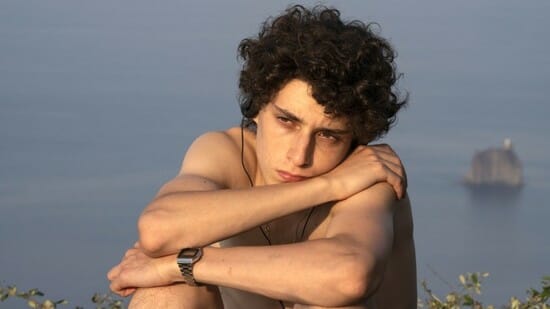
Paolo Sorrentino bookends his new coming-of-age opus, The Hand of God, with divine representation, and spends every moment in between grousing over life’s endless parade of disappointment. Humanity is dreadful. Everything is a failure. Reality is lousy. “What a shitty world this is,” one woman opines around 45 minutes into the movie. “You go buy dessert and when you get back, your husband’s in jail.” The details are irrelevant. It’s the sentiment that lands. The dialogue reads like Sorrentino soliloquizing via his characters, airing grievance after grievance about the grounding effect of The Hand of God’s story on its plot: Set in 1980s Naples, attending to the rich, boring routine comprising the comings and going of the tight-knit family Schisa—father Saverio (Toni Servillo) and mother Maria (Teresa Saponangelo), and their sons, eldest Marchino (Marlon Joubert) and youngest Fabietto (Filippo Scotti)—Sorrentino constructs the film with fewer surrealist flourishes than in his latter-day works, a la 2018’s Loro, 2015’s Youth and 2013’s The Great Beauty, where a man makes a giraffe disappear into thin air in the middle of a Roman colosseum. Placed next to these pictures, The Hand of God is downright normal. Normalcy may not satisfy Sorrentino’s characters, whether principle or supporting, but The Hand of God finds abundance in quotidian Italian conventions: Abundance of meaning, abundance of beauty, abundance of comedy, and so as to avoid burying the lede, The Hand of God is consistently hilarious for the first hour or so (an opening scene of domestic violence notwithstanding). The Hand of God isn’t escapism, contradicting Fabietto’s late-stage career goals. It is an entertaining hoot and a poignant drama that mellows into an exercise in bereavement in its second half, where Fabietto takes his mind off of a world-shattering tragedy by fanboying out over Capuano and getting into trouble with Armando (Biagio Manna), Sorrentino’s secret weapon: A gregarious cigarette smuggler whose wild streak belies abiding loyalty to whomever he calls “friend.” It’s impossible to keep up. The Hand of God doesn’t try to. Instead, guided by Fabietto, the movie takes its time. It watches. It breathes. It captures life with a clarity even Sorrentino’s best efforts haven’t quite—which makes it his best effort to date.—Andy Crump
31. Bad Luck Banging or Loony Porn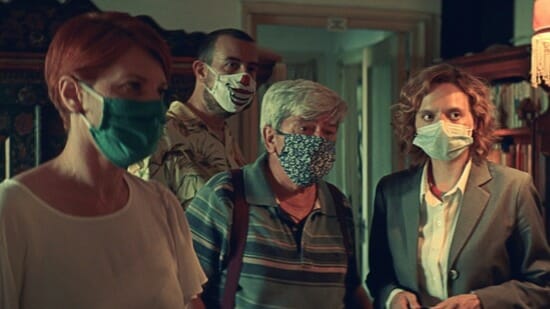
If you’re reading this, chances are that the festival circuit has already spoiled (or warned) that Radu Jude’s Bad Luck Banging or Loony Porn begins with a full-blown unsimulated sex scene. Though it lasts only three minutes, it pretty much runs the gamut of typical sex acts: Fellatio, roleplay, masturbation, dirty talk, penetration, climax. Oh, and one more important detail: The intimate encounter has been filmed, shortly to be leaked on the internet and make its impression on the students and faculty at a private school in Bucharest, Romania. Yet none are more arrested by rabid moral outrage than the schoolchildren’s parents, who are horrified to find out that the woman who dons a pink wig and moans “I’m your slut!” in the video is none other than their kids’ history teacher. The woman who dares straddle the slut/school teacher binary is Emi (Katia Pascariu), who is truly just as horrified that her own private sexual proclivities are now the obsession of local self-righteous, upper-class parents. On top of that, the parents are demanding that the administration hold an informal tribunal to vote on whether Emi should be allowed to keep her job. Divided into three distinct chapters, the self-described “sketch for a popular film” is bookended with two segments following the trajectory of Emi’s plight, the film’s final segment having the pleasure of providing the audience with three wholly different endings for the film, each gradually escalating in its scale of crude cultural commentary. For those who wish to unravel the power dynamics inherent to sex, society and sensual pleasure while experimenting with what we as individuals are comfortable engaging with, Bad Luck Banging or Loony Porn is a masterpiece that stimulates emotionally and philosophically. For those who walk out, well—let’s just be glad they don’t stick around until the film’s final moments, when the prudish parents are forced to understand what it truly feels like having someone else’s morals shoved down their throats.—Natalia Keogan
Together Together is an amiable, successfully awkward surrogacy dramedy that also has the respectable distinction of being a TERF’s worst nightmare. That’s only one of the tiny aspects of writer/director Nikole Beckwith’s second feature, but the gentle tapestry of intimacy among strangers who, for a short time, desperately need each other certainly benefits from the meta-text of comedian and internet terror Patti Harrison’s multi-layered starring performance. Stuffed with bombastic bit parts from a roster of recent television’s greatest comedic talents and casually incisive dialogue that lays waste to media empires and preconceptions of women’s autonomy alike, the film is an unexpected, welcome antidote to emotional isolation and toxic masculinity that meanders in and out of life lessons at a pleasingly inefficient clip. That the tale of fatherhood and friendship is told through the sparkling chemistry of a rising trans star and her entrenched, anxious straight man (an endearing Ed Helms) only adds to Together Together’s slight magic.—Shayna Maci Warner
29. Zola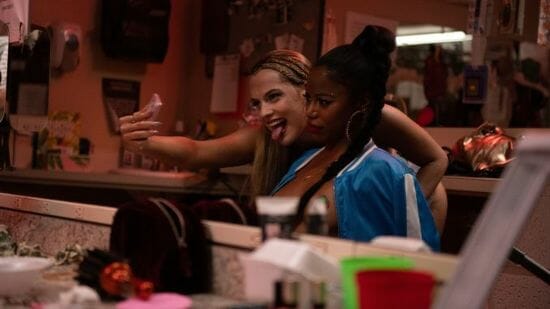
A’Ziah “Zola” King’s ultra-viral Tweet thread—AKA The Story AKA The Thotessy AKA Dante’s Infern-ho—about stripping, sex trafficking and the dangers of braving the surreal and nearly mythological land of Florida with a white girl you barely know, has it all. It’s hilarious and disturbing, with characters noble, treacherous and pathetic, damning voyeurism while encouraging our participation and spectatorship. The social media saga is also a treatise on storytelling. It’s been embellished, deleted and reposted after the dark comedy inherent in the compelling truth was honed for an audience—an evolving epic poem, technologically modernized. Naturally, writer/director Janicza Bravo had her work cut out for her when turning its garish and nightmarish weekend into a film. But she responds in kind, adding in her own tweaks and retellings to heighten the fable. Zola maintains its source’s compelling magic, transforming us from rubberneckers to spellbound participants along for the wildest cinematic road trip of the year. In less capable hands, Zola could’ve been a movie of morbid fascination. But Bravo, who adapted her sophomore feature alongside Jeremy O. Harris, embraces the secondhand spontaneity of the vibe while immersing us in the humanity of its participants. We’re rarely looking at them, as can happen during the sleazy Floridian spectacle of Spring Breakers, but going through it with them. Sometimes that means empathizing with Zola (Taylour Paige) and Stefani (Riley Keough) when they’re feeling themselves, taking selfies in the strip club dressing room. Sometimes that means chuckling sadly when Stefani’s boyfriend Derek (Nicholas Braun, whose clueless giant schtick gets a Malibu’s Most Wanted coat of paint) brags to a stranger in an empty liquor store that they’re in town “making shmoney.” But the shmoney ain’t for nothin’ and these chicks ain’t free, as the next days spiral from a simple strip trip to a messy collision between culture vultures, warring sex traffickers and an ever-increasing desire to get the hell home. Zola continues the fairy tale evolution of King’s story, passing the rich text on with the same outrageous spirit—a level of respect most adaptations only aspire to.—Jacob Oller
28. The Last Duel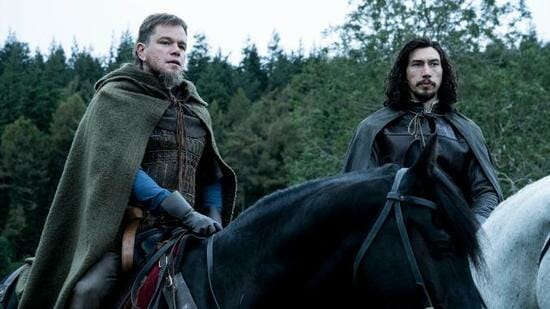
To tell a story that’s been told before, Ridley Scott’s The Last Duel does something a little familiar, and a little different. His medieval epic based on the book of the same name by Eric Jager—concerning the last judicial duel of France—is conveyed across three chapters. In a narrative device easily comparable to Rashomon, another film which details the conflicting accounts surrounding a rape, the script (co-penned by stars Matt Damon and Ben Affleck alongside Nicole Holofcener), sends us back to the beginning three times. The Last Duel retreads the path already taken, but each occasion with a different guide. In some instances, diplomatic actions become violent ones, off-handed glances become indicative of deceit, relationships drastically change, words take on different meanings, and the world is suddenly observed as if we were seeing it for the very first time. Which is why, when we are introduced to the knight Jean de Carrouges (Damon), we come face-to-face with a grizzled, esteemed war hero. He charges into a brutal battle and valiantly hacks away at the enemy forces. Spears enter chests, viscera is sliced, blood sprays to near-comical effect. The squelching of flesh, cracking of bones and clanging of metal is amplified by the film’s impeccable sound design, battle sequences defined by the kineticism of Dariusz Wolski’s camerawork. In this first chapter, we see the world as Carrouges sees it, and it’s a world where he is a respected fighter and dutiful husband who has been wronged by his former friend, and who expresses compassion and swift wrath against the man who committed the sin of rape against his young wife, Marguerite de Carrouges (Jodie Comer). But as the narrative shifts over, we understand that this is not entirely true. Carrouges is perceived as something of a dimwitted blowhard in the eyes of Jacques le Gris (Adam Driver), former friend to Carrouges on the battlefield and squire to Count Pierre d’Alençon (Affleck). Pierre d’Alençon and his squire are infamous womanizers, engaging in orgies and gossiping about how much they hate Jean de Carrouges (which is often funny just by sheer virtue of Affleck and Damon’s real-life friendship). Of course, Marguerite’s chapter provides the most conclusive account of the story, articulating a life lived only at the whims of men. And in the eyes of Marguerite, Carrouges is nothing but a brute she was forced to love, and le Gris is a lustful freak to whom she is only superficially attracted. The character is handled elegantly by Comer, who carries Marguerite with composure masking the ubiquitous glint of terror in her eyes; the quivering yet entirely routine fear of a person whose personhood has been rendered negligible from birth. It is simple to dub Scott’s film a medieval take on #MeToo, and, well, OK, it is. It’s an easily applicable, overtly modern allegory about the implications of coming forward on charges of sexual assault—how women can be just as complicit in the pervasion of rape culture as men are in perpetrating it, and how the costs of saying anything at all can be so dire that it is not worth saying anything at all. But these are things we already know. Such commentary has been done to death at this point, and frequently in ways which come across as tone-deaf and trite. Instead, Damon, Affleck and Holofcener have penned a skilled illustration of how men see the world differently, and how rape culture is born out of these lived-in blind spots. The decision to tell the 150-minute story through three separate ones not only begets a stunningly compelling narrative that allows for multi-layered characters, but it’s a gimmick that gets to the very heart of what the film is trying to say: When men fundamentally see the world in opposition to women, and when that world is then attuned to their whims, there can be only one truth. Ridley Scott directing a grand, riveting medieval epic that doubles as an analysis of gender dynamics might be unexpected, but The Last Duel manages to effortlessly combine Scott’s action sensibilities with an empathetic thread between the past and present.—Brianna Zigler
27. Wheel of Fortune and Fantasy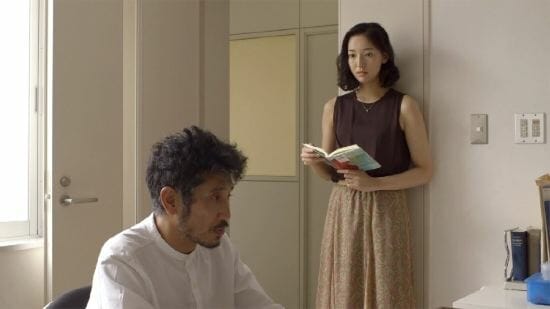
The awkward charm of coincidental encounters is what sets Ryusuke Hamaguchi’s Wheel of Fortune and Fantasy in motion, a collection of three short films about the unexpected outcomes of otherwise mundane interactions. Each segment lasts approximately 40 minutes, focusing on full-length casual conversations and the intense emotions they immediately provoke. The film’s anthology approach works as a compelling contrast to Hamaguchi’s other 2021 feature, Japan’s Oscar selection Drive My Car, which itself is a three-hour adaptation of Haruki Murakami’s short story of the same name. Whether by weaving together standalone shorts or fleshing out an existing text, the director suggests that the subtleties of everyday exchanges often harbor strange secrets. Though none of the stories are connected—or even exist in the same ostensible world—there is a consistent throughline of analyzing performance. Whether it’s achieved through a character playing out imagined scenarios in their mind, communicating the vulnerable passion of sex or roleplaying to receive long-awaited answers to unquelled questions, Wheel of Fortune and Fantasy demonstrates the benefit of inhabiting delusion. In fact, the film’s English-language title addresses this very fixation. The idea of fortune is not inherently bound to prosperity, but rather the more intangible and improbable intricacies of fated consequences. In this sense, the role of fantasy is to act as a salve for the often depressing mundanity of real-life obligations and social mores, whether through speculative daydreams, beguiling lies or invited deceit. Hamaguchi certainly possesses a fascination for depicting multifaceted women in his filmography (Happy Hour, Asako I & II and now Wheel of Fortune and Fantasy as well as Drive My Car), a trait that can surely be traced back to the filmmaker’s decades-long obsession with Cassavetes. This interest is compounded by his prominent focus on romance in women’s lives: In the case of Wheel of Fortune and Fantasy, these relationships range from doormat ex-boyfriends, unforeseen objects of seduction and long-lost loves. However, the women explored in each segment are hardly defined by their success in securing a happy union. Particularly due to the short films ranging from ending on a sour or slightly saccharine note, the characters are given much more room to be frustrated in their relationships—this theme of disharmony in otherwise functional relationships being another recurring motif in Hamaguchi’s films. Both Wheel of Fortune and Fantasy and Drive My Car incorporate themes of the erotic thrill of crafting a narrative, the power in playing pretend, and the malleable and ever-transmogrifying nature of human relationships. Though his highly anticipated Drive My Car distills these musings in a slightly more meticulous manner, Wheel of Fortune and Fantasy cuts to the chase in a way that’s quaintly quirky—and never dull to watch unfold.—Natalia Keogan
26. The Novice
Lauren Hadaway’s The Novice didn’t just surprise me, it ran wild over the rest of the movies I saw at the Chicago Critics Film Festival, trampling over my memories of them until it was certain that all I could think about was Hadaway’s full-throttle style and her film’s blistering performances. Only fitting for a movie about the consequences of toxic overachievement—of what happens when quasi-liberal education is a money-making machine, burning kids like coal. A movie that puts the “extra” in “extracurricular.” The Novice’s anxious and obsessive hustle culture horror wants to be #1 or nothing. No participation ribbons. And none will be necessary: Hadaway’s work signals a leap straight to the top of the podium as one of the year’s best debuts. Writer/director/editor Hadaway has worked most extensively up until now as an ADR and dialogue supervisor and sound editor for movies like Whiplash, and the precision with which she deploys brutal mental and physical obstacles in The Novice—manifested as everything from sound effects to harsh cuts to scribbled credits font—reflects her expertise. And that’s not even mentioning the heart of the film: A ferocious Isabelle Fuhrman as Alex Dall. Dall is a hardcore college freshman, intense in every facet of her life as she rechecks and overthinks physics tests, hooks up with a frat boy simply to get that experience out of the way, and decides to become a varsity rower…despite lacking any experience, y’know, rowing. You’ve probably heard that some filmmakers make cities into “characters.” Hadaway makes the open water into one of life’s only soothing, nearly sexual comforts; the brutalist concrete basement cell housing the team’s rowing machines into its seductive, enabling villain. The latter offers success, records—quantitative proof that Dall isn’t just good, but better than—while also being a sacrificial altar. The Novice’s unrelenting and self-assured neurosis requires some pitch-black punchlines, keyed-in dialogue and aesthetic chutzpah—which Hadaway displays in spades. Keep an eye on her, as The Novice may have just revealed an up-and-coming master.—Jacob Oller
On the beach that comparative literature scholar Leda (Olivia Colman) lounges on throughout The Lost Daughter, the skies are a crystal blue, the beaches a shimmering white, the water warm and translucent. But the shore is also infested with crass, noisy people; Leda’s fruit infected by a malignant rot; her bedroom contaminated with screeching bugs; a little girl’s doll corrupted by noxious black liquid and writhing insects. This tonal tension is symptomatic of the film’s spirit: It’s a glossy apple, rapidly decaying from the inside out. The film takes place over a couple of days as Leda settles into a lavish working vacation. Her relaxation is interrupted, however, when she first lays eyes on Nina (Dakota Johnson), a beautiful, inscrutable young mother. Leda becomes obsessed with Nina, as the latter inadvertently resurfaces troubling memories of Leda’s own distressing experiences as a mother. From that moment onward, Leda’s haunting memories permeate The Lost Daughter until the apple is completely black. While the narrative itself, adapted from Elena Ferrante’s 2006 novel of the same name, is relatively straightforward, debut director Maggie Gyllenhaal, who also wrote the screenplay, tackles themes of internalized and externalized sexism with agility and complexity. Leda’s subtle, complex mental state would not have been possible to convey were it not for Gyllenhaal’s outstanding visual sensibilities. Leda’s struggles are largely internal, but I’m confident that Gyllenhaal’s uniquely tactile storytelling says a great deal more than words ever could. When Leda caresses Elena’s grimy doll, her touch is gentle and somehow filled with regret. When she slides a pin into Nina’s hat, it sounds sinister like a sword being unsheathed, but her careful placement is almost sensual. And when a younger Leda slices the flesh of an orange, her smooth, tactful carving almost feels ominous. Gyllenhaal’s extraordinary direction, paired with exceptional performances from The Lost Daughter’s lead actresses, culminate in a perfect storm that yields an astute portrait of the painful expectations of womanhood.—Aurora Amidon
Japanese filmmaker Nobuhiko Obayashi’s Labyrinth of Cinema might appear more maze-like than labyrinthine at first. An ostensible journey through Japanese cinema and how the practice of filmmaking has come to bear historic significance for the nation, the movie’s timeline-jumping and propensity for abstract tangents initially signal chaos, but eventually pan out as perfectly kaleidoscopic. A distinct central thought eventually emerges, enmeshed within the apparent frenzy: War is an unnecessary human evil, its incalculable horrors evident in the atomic bombings of Hiroshima and Nagasaki and, on an equally nefarious plane, Japanese imperial efforts like the Japanese Boshin Civil War, Russo-Japanese War and World War II. As opposed to a fatalistic or anxious overarching tone, Obayashi’s principle thesis comes loaded with optimism and hope for the future. Labyrinth of Cinema is part magical realism, part film school crash course, part restoration of historical record. On the closing night of the sole movie house on the Onomichi seafront, a programmed all-night marathon of Japanese war films attracts a large and diverse crowd of movie lovers bidding adieu to the beloved locale. When a bolt of lightning strikes the theater, three young men named Mario (Takuro Atsuki), Dugout (Yoshihiko Hosoda) and Tori (Takahito Hosoyamada) are teleported into the films being shown on-screen. As they navigate their newfound celluloid landscapes and follow the beautiful Noriko (Rei Yoshida) between frames, a journey through Japanese cinema brings the men to specific points of historical significance, encouraging them to learn both about the events being depicted and the craft of recreating these moments on screen. The core of the Labyrinth doesn’t hold a destructive force, but rather a restorative one. In order to prevent future generations from perpetuating the same destruction as their predecessors, hands must turn to cinema, to preservation, to peace.—Natalia Keogan
23. Evangelion 3.0+1.0: Thrice Upon a Time
Since 1995, Neon Genesis Evangelion has penetrated the cultural consciousness with giant robots, angsty teens and esoteric Biblical references. It is the story of Shinji Ikari, a young boy destined to pilot a giant robot called Unit-01 in a future where creatures called Angels are destined to destroy humanity. But Shinji resists his fate, complaining at every turn and freezing with indecision as the survival of humanity lies on his shoulder. It is truly a one of a kind franchise, the brainchild of the genius and deeply depressed Hideaki Anno. It is a franchise that has plagued him for over 25 years, from a series to a slew of movies that worked to rewrite a dissatisfying ending. Now, Anno is finally done. With the release of his latest and last piece of Evangelion media, Evangelion 3.0+1.0: Thrice Upon a Time, the time of the Angels has come to an end. Thrice Upon a Time is the fourth Rebuild of Evangelion film, which is a complete retelling of the events from the original series. The final film in the universe of Shinji, Asuka, Rei and EVAs may not be the best place for franchise novices to start, but it should be a great motivator. Rarely do anime franchises end on such a pitch perfect note, but Anno shows it is possible with Evangelion 3.0+1.0: Thrice Upon a Time. After decades of grappling with what this series means to him and using it as a mechanism to process his own emotional baggage, Anno has finally found closure within his broken world full of angst and hope. This is a gasp of relief, a stifled sob of pride that punctuates a cultural milestone. With the release of this film, Anno is finally free.—Mary Beth McAndrews
What’s confusing at first about Roy Andersson’s latest is that it’s not very funny. Known for his wry deadpan—he’s a master at crafting absurdist humor out of seemingly banal situations—the acclaimed Swedish writer-director, who turned 78 last month, is noticeably in a far less jocular mood for About Endlessness. You can find stray chuckles in this slim, quietly moving treatise on the utter futility of everything, but the laughs are overshadowed by the somber realization that Andersson’s typically bereft characters are left to their own devices even more so than usual. Rather than punchlines, we get glimpses of melancholy lives stuck in limbo. About Endlessness doesn’t appear to be that much different than Andersson’s earlier movies, but its tone is more funereal and compassionate. The people we meet aren’t oddballs or objects of derision—they’re struggling too much to be merely “quirky,” and Andersson’s heart goes out to them, even if he doesn’t give them a happy ending. (Truth is, most of them don’t get an ending at all.) If before you marveled at his tightly choreographed dioramas, here you look beyond the stellar precision of his filmmaking. The human beings are front and center. We meet a dentist (Thore Flygel) who, for unknown reasons, is having a bad day. A pair of lovers (Tatiana Delaunay and Anders Hellström) fly silently over a bombed-out city, wrapped in an embrace that’s more protective than warmly romantic. A priest (Martin Serner) has dreams of being crucified. A woman gets off a train, expecting that no one will be there to pick her up. A defeated army trudges through the snow to a prison camp. A man holds a dead, bloodied woman, a knife in his hand. Did he kill her or just stumble upon the crime? This might make About Endlessness sound like a joyless bummer, and yet what’s remarkable is how it produces its own curious form of exhilaration. Partly, it’s due to Andersson’s rigorous filmmaking style, which presents us with these gorgeous little jewel boxes as each mini-portrait plays out in front of his locked-down camera. But also, it’s the inventiveness of the scenarios: Andersson cuts to the core of myriad mundane human experiences in order to find something resonant about, say, an overattentive waiter or a random run-in with an old classmate. The observations are so trenchant that they keep sadness at bay. Yes, we are these people. Their problems are our problems. But they’re still alive, and so are we. Sometimes, we don’t need the patina of humor. We’re strong enough to accept Andersson’s unhappy worldview unfiltered. It’s a slow-burn stunner.—Tim Grierson
21. Procession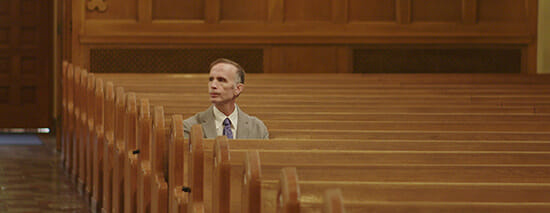
In his films, Robert Greene has tried to bring the alienated past into the present. Kate Plays Christine, from 2016, uses Kate Lyn Sheil’s preparation to play Christine Chubbuck—the newscaster who died by suicide on air 42 years earlier—in part to navigate an actor’s responsibilities when trying to resurrect a real person relegated to folklore. 2018’s Bisbee ’17 chronicled the reenactment, on the event’s 100th anniversary, of the forced removal and abandonment of more than 1,200 striking miners from their homes into the Arizona desert. As Bisbee community members take on the roles of both deputized corporate thugs and workers demanding better lives, in many cases inhabiting the personas of their own ancestors, they come to better understand the sway such history still holds over today. Even in Actress, Greene’s 2014 portrait of Brandy Burre returning to acting as she reinvents her personal life, re-evaluating the past is an act of taking control. When Burre slowly goes back on stage, engaging with old friends and with the visceral excitement of being in front of an audience, she begins to steer her life away from a toxic marriage and define herself anew. She realizes she’s no longer obligated to hold on to her old self. Procession, Greene’s latest film and his first for Netflix, is again about acquitting the present from the past. It begins with a 2018 press conference in Kansas City, Missouri. Lawyer Rebecca Randles stands with three of the survivors stating that they can call out more than 230 known Catholic clergy members in the Kansas City area part of a far-reaching network of sexual abuse. Seeing this, Greene reached out to Randles with the idea to use drama therapy, closely guided by registered drama therapist Monica Phinney, to give a small group of survivors the chance to transform their nightmares into something dramatic, to potentially transform their trauma into something survivable. Procession presents this approach: Six men scripting, storyboarding, location scouting and finally shooting their worst memories, however they want to interpret them, interspersed with the completed results. The young actor who stars in each of the segments, Terrick Trobough, spends much of the film in the company of the six survivors, hearing their stories and quietly, professionally doing his job. He witnesses them weep and punch things and disassociate, not because they’re fragile, but because they’re broken. Terrick responds that he believes their stories. Later, with Dan (one of the survivors) following an emotional moment, Terrick asks him, “How are you?” Maybe he’s just being polite, but Terrick’s small gestures of empathy glow brightly. As does Procession, when the beauty of Greene’s filmmaking satisfies the intelligence and clarity of his methods. “I hope the strength you showed is rewarded with peace and contentment,” another survivor tells himself near the end of the film, reaching decades into the past. A close-up of his face lets the audience know if that hope has been resolved. It’s very good kino.—Dom Sinacola
20. In the Heights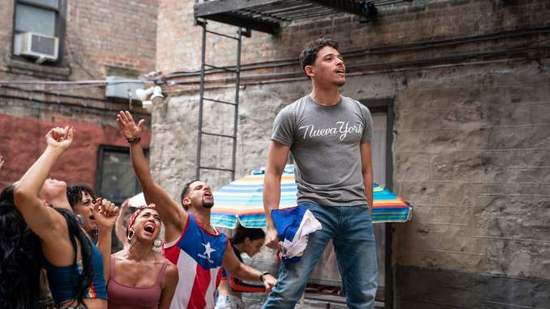
In 2018, director Jon M. Chu imbued the standard rom-com plot of his Crazy Rich Asians adaptation with classical Hollywood decadence, hanging it all on a framework of well-constructed cultural specificity. It was big, spectacular and embarrassingly novel for an American movie of its kind. Now, in 2021, we’re getting Chu’s version of In the Heights, the musical that put Lin-Manuel Miranda on the map (and won him his first Tony). It’s incredible. The exciting electricity of a non-white blockbuster cast becoming superstars before your eyes, the maximalist style of a modern smash updating its influences, the intertwining of hyper-specific and broad themes—Chu’s strengths and his cast soar, bringing In the Heights as high as it’s ever been. It’s the best Hollywood musical in years. Tracking a few sweltering days in New York’s Washington Heights, the film meshes Do the Right Thing’s hot summer tension with School Daze’s teasing affection for its song-slinging genre. It just so happens that the corner we’re on is the collision point for the intersecting lives and romances of two couples—bodega boss Usnavi (Anthony Ramos) and aspiring designer Vanessa (Melissa Barrera), and dispatcher Benny (Corey Hawkins) and recent Stanford dropout Nina (Leslie Grace)—who serve as the neighborhood’s most vocal examples of those that life’s rigged lottery left putting their patience and faith in a daily scratcher. There’s no real pivotal struggle (especially not between Sharks and Jets, though wouldn’t it be incredible if Steven Spielberg’s West Side Story gave 2021 two great NYC musicals?) aside from the ever-present and myriad anxieties of Nth generation Americans living in a racist country. Yes, those familiar with the themes of Miranda’s Hamilton will find a similar rhythm and thematic flavor here—though with the showtunes’ style slipping into a salsa or bolero as easily as the rap bars dip in and out of Spanish—but with a purity of form and meaning that’s lyrical critiques and observations are even sharper than those mired in the phenomenon’s historical metaphor. But as much as Miranda’s sensibility is ever-present throughout the film, it’s a blessing that Ramos takes over as the lead, using the full breadth of his impressive AAA charm to assure every last unconvinced soul that he is one of our great stars. Singing, rapping, dancing, pining over Vanessa, pining over the Dominican Republic, bumbling, speaking in direct address (always a test of charisma), exuding a casual sexiness—Ramos is the platonic ideal of a romantic leading man and exactly who we need guiding us through the musical’s everyday complexity. But nobody, not even Ramos, can hold a candle to Olga Merediz, the sole original Broadway performer to reprise her role. She was Tony-nominated for her stage performance as the barrio’s honorary abuela, Claudia, and I’d be happy if she was Oscar-nominated for bringing it to film. Her song, “Paciencia y Fe,” is a show stopper, the most moving and emotionally intelligent of the film, that’s staged in the most inventive way. In fact, almost all the songs are bangers that keep emotions high—you’ll weep, you’ll cheer, you’ll hum the songs to yourself on the way out of the theater—bolstered by orchestration that, while restrained when limited to its lovers, explodes when the choruses finally incorporate the neighborhood at large. Head-bobbing bops and moving melodies match rhythmic editing and a vibrant, fittingly populous background that’s constant choreography sustains the perpetual, organic flow of a community. In the Heights is great, and its greatness is amplified by the joy that it will inspire in theaters full of people for years to come.—Jacob Oller
19. Titane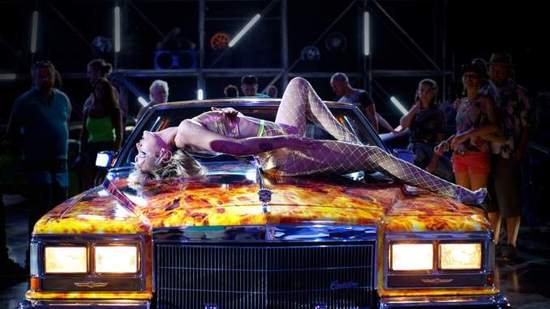
Alexia (Agathe Rousselle) had an early connection with cars. Her insistence on using her voice to mimic the rev of an engine as a young girl (played by Adèle Guigue) while her irritated father (French director Bertrand Bonello) drove was so undaunted that one day she caused him to lose control of the vehicle. The accident rendered her father mostly unscathed, and Alexia with a titanium plate implanted in her skull. It was a procedure that seemingly strengthened a curious linkage between her and metal and machine, an innate affection for something hot and alive that could never turn away Alexia’s love. As the doctor removes Alexia’s surgical metal headgear, her father looks on with something that can only be described as disdain for his child. Perhaps, it is because he knew what Alexia would become; perhaps, Alexia was just born bad. Julia Ducournau’s Palme d’Or-winning follow-up to 2016’s Raw crunches, tears and sizzles. Bones break, skin rips, libidos throb—the human body is pushed to impossible limits. It’s something that Ducournau has already proved familiarity with, but the French director takes things to new extremes with her sophomore film. Titane is a convoluted, gender-bending odyssey splattered with gore and motor oil, the heart of which rests on a simple (if exceedingly perverted) story of finding unconditional acceptance. Eighteen years following the childhood incident, Alexia is a dancer and car model, venerated by ravenous male fans aching to get a picture and an autograph with the punky, sharp-featured young woman. She splays her near-naked form atop the hood of an automobile to the beat of music, contorting and touching herself with simmering lust for the inanimate machine adorned with a fiery paint job to match Alexia’s sexuality. Pink and green and neon yellow glistens on every body (chrome or otherwise) in the showroom, but Ruben Impens’ cinematography follows Alexia as she guides us through this space where she feels most at home. Titane persists as a boundary-pushing exploration of the human form, of gender performance, masculinity and isolation; Ducournau’s script is surprising, shocking, titillating at every turn. And despite her cruelty, and the relative distance from and lack of insight into her character, Alexia remains an empathetic protagonist. This is in no small part thanks to Rousselle’s commanding portrayal which astonishingly doubles as her feature debut. Titane is not just 108 bloody minutes of bodily mutilation and perversion, but of blazing chaos inherent in our human need for acceptance. Ducournau has wrapped up this simple conceit in a narrative that only serves to establish her voice as one which demands our attention, even as we feel compelled to look away. Yes, it’s true what they’ve said—love will literally tear us apart.—Brianna Zigler
18. Red Rocket
A wave of early aughts nostalgia immediately saturates Red Rocket, Sean Baker’s latest exploration of echt-Americana, by way of NSYNC’s eternal hit “Bye Bye Bye,” which blares as Mikey Saber (Simon Rex) disembarks a bus arriving in his Texas hometown. Unfortunately for Mikey, this wave is the same one that washes him up here. Having left his small Gulf Coast town to pursue adult film acting in Los Angeles 20 years prior, his return is essentially admitting defeat. But Mikey appears anything but embittered, a spring in his step as he walks through the desolate streets despite his precarious position. Portrayed with beguiling (though at times disagreeable) levity by Rex, Mikey is the center of Baker’s most complex character study to date—all while maintaining the director’s focus on power dynamics, American disillusionment and those on the margins of society (albeit with an added air of compelling moral ambiguity). With no means to secure honest work or cash unemployment checks as an out-of-state resident, Mikey falls back into his old gig of selling weed for local supplier Leondria (Judy Hill), who is equally baffled by his return. Nearly entrenched in a period of regression, Mikey becomes deeply enamored with a 17-year-old cashier at The Donut Hole named Strawberry (Suzanna Son)—pulling him out of his plan to rekindle his relationship with his wife, vying instead to utilize the young girl as his ticket back into the sex industry. While this description makes it easy to write Mikey off as an irredeemably slimy creep, Rex brings an impenetrable air of endearing himboism to the role that makes it absolutely impossible to hate Mikey—a performance indicative of Rex’s indelible talent. The actor’s vulnerability when it comes to revealing a shameless showbiz sensibility while bearing (fore)skin is inextricably tethered to Rex’s own adult film past and integration into VJ-stardom and Scary Movie sequel stints. It imbues the film with the sort of docu-style realism Baker perpetually strives for, only this time choosing to depict an individual who straddles, crosses and distorts his own position of power. By way of candid humor, a magnetic performance from Rex and Baker’s careful attention for authenticity, Red Rocket is a sympathetic profile of a porn star past his prime. In spite of his sleazy nature, Mikey Saber is an enchanting character whose pride (and relative privilege) shields him from the relative shambles of his surroundings, both on hyperlocal and national planes. Yet Mikey is hilarious and heartfelt by way of his shortcomings: Sometimes, disreputable people are the funniest, sweetest and sexiest ones out there—and isn’t that just wonderful?—Natalia Keogan
17. Pig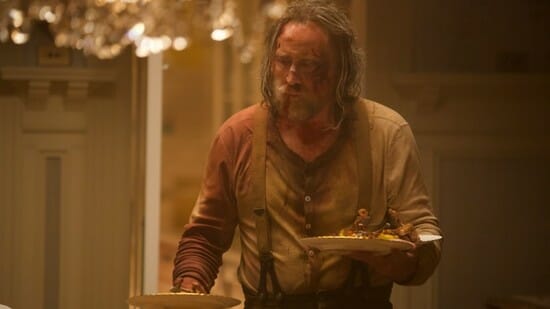
In the forest outside Portland, a man’s pig is stolen. Rob (Nicolas Cage) is a witchy truffle forager that we learn used to be a chef—a Michelin-starred Baba Yaga, a gastronomical Radagast—who sells his pig’s findings to sustain his isolated life. What follows is not a revenge thriller. This is not a porcine Taken. Pig, the ambitious debut of writer/director Michael Sarnoski, is a blindsiding and measured treatise on the masculine response to loss. Featuring Nicolas Cage in one of his most successful recent permutations, evolving Mandy’s silent force of nature to an extinct volcano of scabbed-over pain, Pig unearths broad themes by thoroughly sniffing out the details of its microcosm. The other component making up this Pacific NW terrarium, aside from Rob and the golden-furred Brandy’s endearingly shorthanded connection, is the guy Rob sells his truffles to, Amir. Alex Wolff’s tiny Succession-esque business jerk is a bundle of jagged inadequacies, and only Rob’s calloused wisdom can handle such prickliness. They’re exceptional foils for one another, classic tonal opposites that share plenty under the surface of age. Together, the pair search for the pignapping victim, which inevitably leads them out of the forest and back into the city. There they collide with the seediest, John Wick’s Kitchen Confidential kind of industry underbelly you can imagine, in a series of standoffs, soliloquies and strange stares. It’s a bit heightened, but in a forgotten and built-over way that feels more secret than fantastic. The sparse and spacious writing allows its actors to fill in the gaps, particularly Cage. Where some of Cage’s most riveting experiments used to be based in manic deliveries and expressionistic faces, what seems to engage him now is the opposite: Silence, stillness, realist hurt and downcast eyes. You can hear Cage scraping the rust off Rob’s voice, grinding the interpersonal gears much like the dilapidated truck he tries (and fails) to take into town. Wolff, along with much of the rest of the cast, projects an intense desperation for validation—a palpable desire to win the rat race and be somebody. It’s clear that Rob was once a part of this world before his self-imposed exile, clear from knowing gazes and social cues as much as the scenarios that lead the pig-seekers through basements and kitchens. Part of Pig’s impactful, moving charm is its restraint. It’s a world only hinted at in 87 minutes, but with a satisfying emotional thoroughness. We watch this world turn only slightly, but the full dramatic arcs of lives are on display. A sad but not unkind movie, and certainly not a pessimistic one, Pig puts its faith in a discerning audience to look past its premise.—Jacob Oller
16. Sator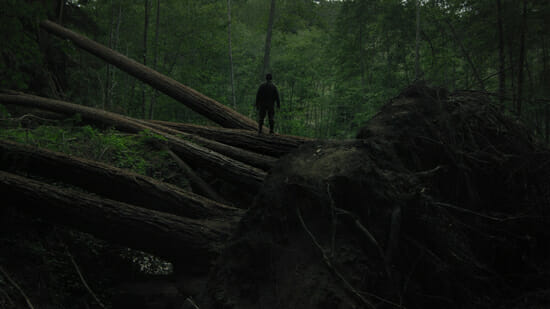
There’s something in the forest. But at the same time, there’s nothing much at all. A man, a cabin and maybe—maybe—something more. Sator, a mumblecore horror somewhere between a modern-day The Witch, The Blair Witch Project and Lovecraft, is a striking second feature from Jordan Graham. It’s the kind of horror that trades jump scares for negative space, one that opens with imagery your typical A24 beast saves for its finale. Sator’s dedication to its own nuanced premise, location and tense pace makes it the rare horror that’s so aesthetically well-realized you feel like you could crawl inside and live there—if it wasn’t so goddamn scary. Sator is a name, an evocation, an entity. He’s first described, by Nani (the late June Peterson, excellent), as a guardian. Nani’s known Sator (whatever he may be) for a long time. The film represents shifts in time, and the physical transportation to places soaked in memories, with an aspect ratio change and a black-and-white palette. Nani’s lovely longhand script is practiced well from a lifetime of automatic writing, with the words—including some of the opening company credits, which is a great little joke—pouring from her pen and claiming a headwater not of this world. That same paranormal river flows to her grandson Adam (Gabriel Nicholson), that aforementioned man in the woods, whose relationship with the voices in his head is a bit less comfortable. It’s a stark, bold, even compassionate film—which offers imperfectly planted details of a battered and bruised family at its core—with plenty to comprehend (or at least theorize about) for those brave enough to venture back into the forest for a rewatch. As scary as it is, Sator is an experience with enough layers and craftsmanship that its alluring call will rattle in your head long after you’ve turned it off.—Jacob Oller
Based on Jiro Taniguchi’s early ‘00s manga, which added breathtaking environmental illustrations and sharp, shadow-intensive character designs to Baku Yumemakura’s 1998 novel, The Summit of the Gods is a testament to self-motivation through the intertwined stories of two men: Mountain climber Joji Habu (Eric Herson-Macarel) and journalist Makoto Fukamachi (Damien Boisseau). Director Patrick Imbert’s French anime sees the two cross paths thanks to a legendary Vestpocket Kodak camera belonging to George Mallory, the English mountaineer who may or may not have reached the top of Everest in the ‘20s. Fukamachi sees Habu with the camera, then loses him. Fukamachi wants a scoop; Habu wants to be left alone as he prepares for his own climb. In his search for the recluse, Fukamachi compiles Habu’s life, constructing his obsessive arc event by event through unearthed news clippings. With this intercut structure, The Summit of the Gods is both a great journalism movie and great mountaineering movie—each with a series of technical steps that contain emotional weight impossible to fully explain to an outsider. Why does one seek the peak? Why does one devote themselves to finding all the details of a story? These lonely goals are personal as much as professional. The end result is clear, but the reasoning behind it all quickly becomes murky and existential under scrutiny. The clarity of the animation backs up these large questions with simple answers. The majestic, hazy colors of nature—bright blues and purples—contrast against day-to-day living in condos, barrooms and city streets that’ve lost all romance. The latter are utilitarian in their detail, so richly filled with realistic stuff as to dull you with familiarity. Then the movie takes you out on the expeditions, through the eyes of the people who live for it. The climbing sequences feature shots so stark and layered with slurries and sunbeams that their painterly abstraction will leave your jaw hanging in the snow. And yet, on a moment-to-moment level, it’s a detailed crunch of piton into stone—of clever rope knots and the muscular friction of hands and feet—undertaken by characters that move with a deliberate intent, their animations weighty enough to leave footprints and mini avalanches of pebbles. The Summit of the Gods is a subtle movie, told in shades of white and degrees of silence, but its passion burns hot beneath the icy rime. Its complex storytelling and convincingly lovely vistas make its philosophical case well: Whether you’re risking it all to get to a peak, to get to the bottom of a mystery, or to create a painstaking piece of animation, you’re lucky enough to have something you love.—Jacob Oller
14. Parallel Mothers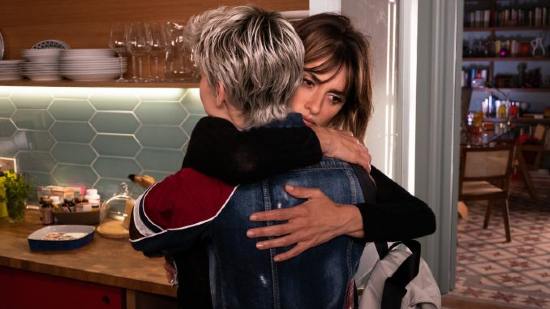
Set in 2016, Parallel Mothers follows Janice (Penélope Cruz), a professional photographer in her 40s who begins a casual fling with forensic anthropologist Arturo (Israel Elejalde). Nine months after a particularly steamy encounter, she checks herself into a Madrid hospital’s maternity ward, preparing to give birth and raise her child as a single mother. As fate would have it, her roommate is in a similar position, save for the fact that she’s over 20 years Janice’s junior: Ana (newcomer Milena Smit) is also without a partner, her only support during labor being her self-absorbed actress mother (Aitana Sánchez-Gijón). While Janice is thrilled that she’s been given the impromptu opportunity to become a mother, Ana is initially resentful of the circumstances that have led to her pregnancy. Yet the two women quickly bond, taking strolls down the sterile hospital halls in order to help their babies descend down the uterus. Coincidentally, they both give birth to beautiful baby girls, and exchange numbers in order to keep in touch as they embark on the journey of newfound motherhood. Though the film sets itself up as an straightforward examination of the peculiar perils of parenthood—particularly for women who raise children outside of the confines of conventional, heterosexual nuclear families—Pedro Almodóvar instead utilizes multiple generations of matriarchs to bring light to the families irreparably broken by the cruelty of Spain’s not-so-distant fascist regime. The initial reason why Janice approaches Arturo is to inquire if he could use his connections to organize an excavation of a mass grave in her hometown—one of the bodies buried being that of her great-grandfather. In many ways, Parallel Mothers is also an atonement on Almodóvar’s part for his own distancing from this period of Spain’s history, particularly considering that his own film career flourished after Franco’s decline. For a director who has never shied away from portraying society’s most controversial taboos on-screen—incest, rape, suicide attempts, pedophilia and even golden showers—the fact that it has taken him his entire career to explicitly incorporate the effects of the Spanish Civil War into his work demonstrates the country’s relative inability to reckon with it. Though Almodóvar has stated that none of his own family members were victims of fascist brutality, his dedication to the ongoing plight of the families of those who perished infuses the film with an almost uncharacteristic sense of levity and sorrow. While this is certainly a shift in the filmmaker’s melodramatic and outlandish sensibilities (though this has been shifting significantly since his 2019 semi-autobiographical Pain and Glory, followed by the deconstructive short The Human Voice), it never feels mishandled in his grasp, always remaining sensitive even while incorporating shocking twists and revelations. Particularly paired with Cruz’s knockout performance of a woman whose life endures the legacy left by the trauma of her family’s unresolved past, Parallel Mothers is a deeply political example of what is lost when we have forgotten—and what is achieved when we fight to remember.—Natalia Keogan
As was the case with 2014’s The Grand Budapest Hotel, The French Dispatch is a story within a story—or, in this case, multiple stories within a story, and there are stories within those stories as well. Wes Anderson remains a creative force to be reckoned with. Frequently rebuked by naysayers for his commitment to his finely-tuned, “quirky” filmmaking style, The French Dispatch proves he is more interested than anything in how to play around with the medium of film and find new ways to tell his stories. Here, he challenges himself to a far more intricate means of storytelling, which is occasionally convoluted but fosters an eagerness to return to the film—to revisit and discover something new. Additionally, he trades previous forays in stop-motion animation for an extended 2D animated chase scene, and even briefly swaps his prototypically stationary, symmetrical camerawork for a dinner table sequence in which the camera slowly revolves around the seated characters, creating a novel and striking dimensionality to his cinematography. Timothée Chalamet, Jeffrey Wright and Benicio del Toro, in their respective first collaborations with the director, could not have been more perfectly attuned to Anderson’s highly specified wavelength. Even minor roles from new Anderson inductees like Elisabeth Moss, Henry Winkler, Christoph Waltz and Rupert Friend are, as could be expected from a perfectionist like Anderson, a snug fit. The precision with which Anderson once effortlessly deployed anguish, familial strife, love, insecurity and, perhaps above all, loss, within his carefully constructed signature filmmaking is largely absent from his newest endeavor. The various storytelling gimmicks take center stage, while the characters are forced into the back seat. The film becomes a wry showcase for the director’s evolution as a creative who has been refining an unparalleled style for over two decades, with a sharper humor but without the more deeply felt pulse of films like The Darjeeling Limited, Fantastic Mr. Fox or most recently, and most effectively, The Grand Budapest Hotel. Still, it’s not to say that The French Dispatch’s bones are absent of any meat at all. “What happens next?” ends up a proportional sentiment to that of the film’s titular publication, the disappearing town it’s set in and the overall theme within Wes Anderson’s tenth feature: The eternal battle between art and capital. The question of “What happens next?” is less an inquiry as to the future of a shuttered, fictitious publication than a worrying, real-life prophecy, and The French Dispatch acts as a dialogue with this fear of the future of art. In this respect, it’s hard to argue that this latent dissolution of character depth is a net negative, when Anderson is clearly interested in, more than anything, growing and evolving as an artist.—Brianna Zigler
12. Shiva Baby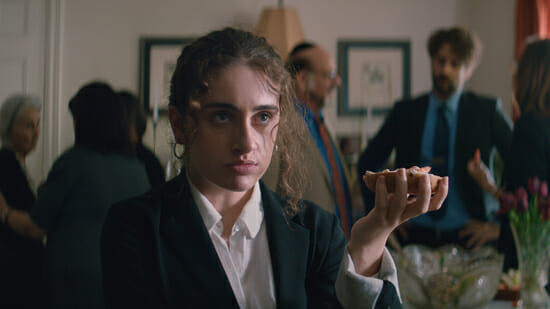
Marvelously uncomfortable and cringe-inducingly hilarious, Emma Seligman’s Shiva Baby rides a fine line between comedy and horror that perfectly suits its premise—and feels immediately in step with its protagonist, the college-aged Danielle. Played by actress/comedian Rachel Sennott, already messy-millennial royalty by virtue of her extremely online comic sensibility, Danielle is first glimpsed mid-tryst, an unconvincing orgasm closing out her perfunctory dirty talk (“Yeah, daddy”) before she dismounts and collects a wad of cash from the older Max (Danny Deferrari). Though it’s transactional, as any sugar relationship tends to be, Danielle seems open to discussing her nebulous career aspirations with Max, and he gives her an expensive bracelet—suggesting a quasi-intimate familiarity to their dynamic, even if the encounter’s underlying awkwardness keeps either from getting too comfortable. As such, it’s a smart tease of what’s to come, as Danielle schleps from Max’s apartment to meet up with her parents, Debbie (Polly Draper) and Joel (Fred Melamed, naturally), and sit shiva in the home of a family friend or relative. That Danielle’s unclear on who exactly died is a recurring joke, and a consistently good one, but there’s little time to figure out the details before she’s plunged into the event: A disorienting minefield of small talk, thin smiles and self-serve schmear. You don’t have to be Jewish to appreciate the high anxiety and mortifying comedy of Seligman’s film, though it helps. Underneath all the best Jewish punchlines lies a weary acknowledgement of inevitable suffering; the Coen Brothers knew this in crafting A Serious Man, their riotous retelling of the Book of Job, and Seligman knows it in Shiva Baby. That the climax involves shattered glass, helpless tears and a few humiliations more marks this as one of the most confidently, winningly Jewish comedies in years.—Isaac Feldberg
Being a teenager in a suburban town can be excruciatingly boring. With no variety in routine, everything feels useless. But then, sometimes, something appears that banishes that monotony and breathes excitement into an otherwise dull existence. That discovery can be revelatory; life can suddenly have purpose. In the case of the trio of delinquents in Kenji Iwaisawa’s incredible debut feature, the animated On-Gaku: Our Sound, they discover the catharsis and power of music. On-Gaku: Our Sound is writer/director Iwaisawa’s love letter both to the power of music and to the manga of the same name by Hiroyuki Ohashi. As the film progresses through its musical numbers, Iwaisawa experiments with form (like expressive rotoscoping) as certain songs evoke different emotions from his characters, whether it is a kindly folk song or a primitive-feeling rocker that reverberates in a listener’s chest. In contrast to the visual style, the phenomenal deadpan comedic delivery is reminiscent of American animated comedies of the ‘90s like Beavis and Butthead or King of the Hill. Kenji in particular embodies that tone, through both line delivery by Japanese rock legend Shintarô Sakamoto and a design that includes an unrelenting stare, thin mustache that zigzags across his upper lip and shiny, bald head. Despite being a high school student, Sakamoto’s grizzled voice gives Kenji the vibe of a tired old man who has seen everything, when really he’s just a bored teenager who smokes too many cigarettes and watches too much TV. Iwaisawa’s own passion fills the chilled-out slacker comedy with a lot of heart and a gorgeous variety of animation styles.—Mary Beth McAndrews
10. West Side Story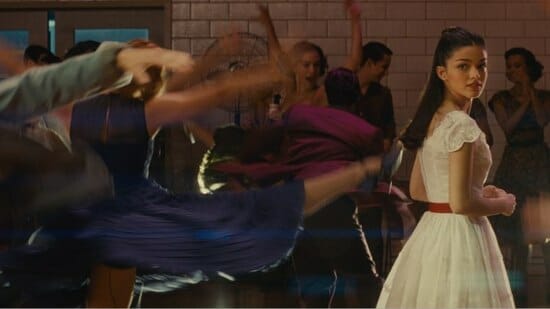
Shoot it loud and there’s music playing; shoot it soft and it’s almost like praying: Steven Spielberg’s West Side Story pumps the classic for exactly that, classicism, by milking the musical’s dynamics for maximum expressiveness. Its romance? At its most tender. Its dance? At its most invigorating and desperate. Its songs? As if “Maria” or “Tonight” needed another reason to stick in your head, they’re catchier than ever. Even if you don’t know the lyrics, you know the snaps. And you won’t even need that level of familiarity to get swept up. Spielberg’s been working up to a full-throated musical for decades and he comes at this movie like he’s got something to prove: If there was ever any doubt that he’s a cinematic peer to Leonard Bernstein and Stephen Sondheim, West Side Story sets it firmly aside. It’s a stunning, loving spectacle that confidently scales the fence right to the top of the movie-musical pack. Justin Peck, choreographer of the New York City Ballet, highlights the characters’ simmering physical threat and sexual power (not mutually exclusive among the charged dancers) by making the most of his performers’ long limbs and extravagant costumes. Bright dress ruffles and beefy arms twirl in magical, powerful symmetry. Spielberg, in turn, stages the numbers to fully explore the space (when sparring in the salt warehouse or on the dance floor) or lack thereof (when melting hearts in Tony and Maria’s fire-escape rendezvous). Nearly every shot is foregrounded with impediments, be they chain-link fences keeping the boys trapped in their circumstances, onlookers framing spotlit dancers, or wrought iron grating separating lovers. It’s a city, after all. Cluttered. Messy. Full of people, things—and potential. Attraction. Camaraderie. Respect. Encapsulated in stand-offs and close-up faces. These are shots that already look like classics, not because they mimic the 1961 film (though Spielberg’s clearly a fan and nods its way in a few key moments), but because they look like they were dreamed, planned and pulled off. You can feel the achievement, yet there’s nothing stagey here: The film’s two-and-a-half hours either zip along or linger so closely around the campfire glow of its couple’s radiating affection that you’d happily stay with them all night. With Rachel Zegler as Maria, surrounded by other scene-stealers performing some of Broadway’s best, it also feels like a sure-fire hit. If you’ve never been a musical person, here’s your way in. If you’re already a convert, Steven Spielberg will make you love West Side Story all over again.—Jacob Oller
9. This Is Not a Burial, It’s a Resurrection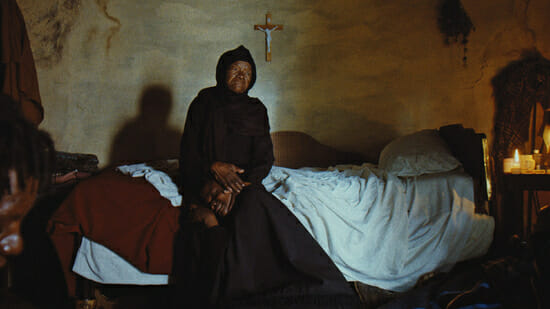
In Lemohang Jeremiah Mosese’s extraordinary new film This Is Not a Burial, It’s a Resurrection, God isn’t present, probably because the sheer volume of suffering visited upon its protagonist alone is enough to make Him feel sheepish. Mantoa (Mary Twala Mhlongo), a widow in the Lesotho village of Nasaretha—so named by missionaries who, ages ago, came through the region in blissful ignorance of its history—is alone. Her son, her last living relative, has died in a mining accident. Her husband died years prior, as well as her daughter, and her grandchild. Mantoa’s life is the definition of bereft. No amount of well-wishes or condolences can ease her pain. And then the Lesotho government decides to build a dam on her mountain hamlet and flood the place out. At least they have a plan to displace the villagers. (Your shock of the day: This is actually a real thing.) But they don’t put much thought into the bodies buried beneath the earth. The tally is so high and reaches so far back that the land’s true name is “the plains of weeping,” which, in the thinnest of silver linings, feels like an appropriate appellation given the atmospheric tragedy of Mosese’s film. This Is Not a Burial, It’s a Resurrection holds nothing back: Not aesthetics, not performance, not tone or sensation. Mosese composes his film as one part tone poem, one part scathing political critique, one part dirge and one part memorial, because death is a complex beast. Saying goodbye hurts, especially when you’re the last one left, like Mantoa. But This Is Not a Burial, It’s a Resurrection, in between the sound of grief that’s somehow inchoate and eternal, finds the space to celebrate life through the marking of death. There’s a Grecian quality to Mosese’s writing and filmmaking. He delicately links each scene together with narration from a nameless lesiba player (Jerry Mofokeng), who often makes himself known through monologues about history and the film’s current events, gently playing his country’s national instrument as punctuation to his words. Mokofeng is one of Mosese’s two constants alongside Mhlongo, who provides This Is Not a Burial, It’s a Resurrection with its steady, stoic heart. The film’s otherworldly near-surrealism, the product of the thought and intention driving it, is given grounding through their work. The fate threatening Nasaretha is unbelievable, even though history has a habit of driving people out of their homes, whether with water or highways. But Mhlongo, Mofokeng and Mosese make us believe—not in God, but in people, the highest power in a staggering movie about powerlessness.—Andy Crump
Licorice Pizza is writer/director Paul Thomas Anderson’s second ode to Los Angeles in the early 1970s: A city freshly under the oppressive shadow of the Manson Family murders and the tail end of the Vietnam War. But while in his first tribute, Inherent Vice, the inquisitive counter-culture affiliate Doc Sportello (Joaquin Phoenix) earnestly engages with his surroundings and follows the threads of societal paranoia all the way to vampiric drug smuggling operations and FBI conspiracies, Licorice Pizza’s protagonist, 25-year-old Alana Kane (Alana Haim), refuses to follow any such thread. A bored, directionless photographer’s assistant, Alana nonchalantly rejects any easy plot-point that might help us get a grasp on her character. What are her ambitions? She doesn’t know, she tells successful 15-year-old actor Gary Valentine (Cooper Hoffman, son of Philip Seymour Hoffman) over dinner at a restaurant called Tail o’ the Cock. What interests and excites her? It’s hard to say. When Gary first approaches Alana while she’s working picture-day at his high school, it’s hard to imagine that Licorice Pizza isn’t going to follow the playful design of a sunny Southern California love story. Alana is instantly strange and striking, and—when Anderson introduces her in a languid dolly-shot with a mini-skirt, kitten-heels, slumped shoulders and a gloriously pissed expression—we are compelled to fall in love with her, just like Gary does, at first sight. Of course, Anderson quickly rejects the notion that Licorice Pizza is going to be a straightforward romance. Anderson knows that this ambling, disjointed structure reflects what it’s like to be young, awkward and in love. Each shot, filled with dreamy pastels, glows with a youthful nostalgia. Anderson and cinematographer Michael Bauman balance out this haziness with a unique control of the camera, implementing long takes, slow dollies, and contemplative pans galore. What is it that Alana gets from being friends with someone ten years younger than her? And why does Gary always return to Alana even when she tries her best to put him down? Like gleefully gliding through the streets of L.A. in the midst of a city-wide crisis, it’s a madness you can only truly understand when you’re living it.—Aurora Amidon
7. Days
Early in Tsai Ming-liang’s Days—in the second or third shot, in fact, so something like 10-15 minutes into the film—we’re left to ponder Lee Kang-sheng’s third nipple. In a soaking pool, at a bathhouse maybe or somewhere health-care-related, Kang (when he has a name, Tsai often refers to Kang-sheng’s characters as “Kang” or “Hsiao-kang”) silently, nakedly floats, the camera mostly consumed with his torso, our view of that third nipple practically sharpened by the pane of still water between us and his skin. He dozes, not for the last time. The water in which Kang is submerged reflects the essences of what lies outside of frame—reflecting his vulnerability by intimating much more vulnerable flesh just below our view—as much as it reminds us of Days’ opening shot, where Kang sits in a chair staring out a window, the window between us and Kang, watching a rainstorm pick up, the shadows of tropical trees shaking in the drop-littered glass. (Water too, usually flooding urban spaces, makes for a constant motif in Tsai’s films.) The longer we watch him, the more we feel as if he’s outside in the storm, or the storm is inside the room with him, watching itself rage. And the longer we watch this nipple, consider it and everything that lends it context, the more we’re encouraged to think of it within the world of Tsai’s previous feature films (Days his 11th). And the more we reminisce about all the films in which that third nipple was there, under Lee’s shirt or lost to the sumptuous grain of 35mm film, the more we see all of Tsai’s work as a slipstream, in which the “same” people live scores of alternate but intertwined lives, each film a brief but meaningful glimpse into how these lives meet—or don’t meet—skeins in the broad tapestry of loneliness and alienation that increasingly consumes us. The third nipple was there all along. Meanwhile, Days as a title pretty much represents the trajectory and velocity of our course. We look in on the quotidian of Non (Anong Houngheuangsy), sitting with him as he prepares dinner, takes a shower, eats, sleeps, wanders through markets. There is no story to this, only habit and survival and the soothing gestures of ritual. Days marks the point in Tsai’s filmmaking at which he’s reached his most empirical; if for each film, beginning with 1992’s Rebels of the Neon God, the Taiwanese filmmaker has gradually peeled plot from the gnawed bone of simply captured human experience, then in Days functionally nothing is explained. We’re not even afforded subtitles (on purpose, as an opening title card informs us) for the film’s few passing glances of dialogue. We’ll watch from across the street, buses and walkers occasionally obscuring our view, unable to hear if they’re talking, unable to make out if their lips have any purpose. All we know is for that long moment, they’re no longer alone. And after all this time spent in their company, that knowledge is more than enough.—Dom Sinacola
6. Nine Days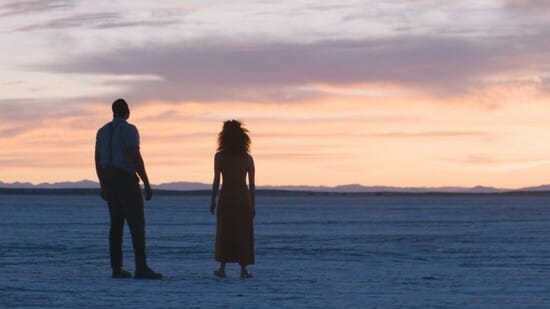
In a small house, alone in the desert, Will (Winston Duke) watches. Nine Days, the wrenching feature debut from writer/director Edson Oda, understands that we are an existence of voyeurism. We’re only truly living to our fullest when we can see, share, feel the experiences of others. Will is a sort of hiring manager for life itself. As painful as it is for him to accept (he’s obviously grown fond of his previous picks), there is a new vacancy, and there are a few candidates. Over a nine-day process, almost like an audition for a reality show—especially fitting considering that the plane they would leave behind houses a watcher carefully and compassionately taking in a televised wall of literal life-streams—Will and his friend/co-worker Kyo (Benedict Wong) whittle down the applicants to find the best person suited for the gift of worldly existence. Oda’s compact, stirring, metaphysical sci-fi stageplay about the ends and beginnings of life—and all the wonder ripe for the sharing contained between—is as moving a debut as you’ll see all year. First, it takes some real creative brass to try to tackle such an ambitious, heady and easily trite topic. Second, it takes some major storytelling talent—both in the crafting of the script and the handling of its actors—to overcome those obstacles while keeping the dignity of all involved intact. Nine Days has quiet confidence, written in the way that some of the best sci-fi is, where it feels like a massive text that’s been erased down to the barest elements necessary for a perception imagination to piece together—a painting of overwhelming sentiment depicted with the simplest strokes possible. Oda’s script has been visualized with a similar restraint, nearly contained to Will’s home and its screens before it slowly pushes at these boundaries. But, at first at least, Will’s hopefuls—including Tony Hale, Bill Skarsgård, David Rysdahl, Arianna Ortiz and a last-minute Zazie Beetz—are roped into routine. As the would-be humans continue to prove themselves through a series of psychological tests, their growth or stagnation metered out in compellingly restrained segments overseen by Duke’s stoic yet compassionate shepherd, we become as invested as Will in their prospects. The gravity of what they’re after hits us. The ultra-sincere Charlie Kaufman/Spike Jonze-esque premise (Jonze executive produced the film) moves beyond its high concept and starts digging into its emotional implications. Scene after scene of appreciation for the magical moments of life hammer our hearts. Rarely do movies so tenderly tenderize you. It can be shatteringly bittersweet even without the soaring strings of Antonio Pinto’s score, and when they come in, it’s not even fair. Admirably ambitious and bracingly sincere, Nine Days leaves you raw and refreshed. Nine Days marks Oda as one of our most exciting new directors, a filmmaker possessing an innovative cinematic mind with a heart to match.—Jacob Oller
5. Benedetta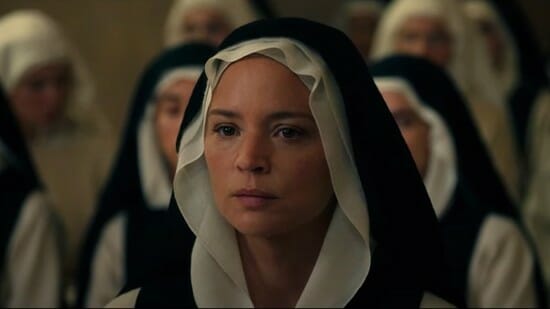
The power and body of Christ compel the characters of Paul Verhoeven’s Benedetta, which ruminates on the raunchy interiority of a lesbian relationship realized inside of the sacred confines of a convent in 17th century Italy. The carnal Catholicism which permeates the film is at this point to be expected from the 83-year-old Dutch filmmaker—but equally so is the film’s ability to utilize eroticism as a vehicle to examine pain, paranoia and power. Based on Judith Brown’s 1986 non-fiction book Immodest Acts: The Life of a Lesbian Nun in Renaissance Italy, the same-sex relationship between Benedetta Carlini (Virginie Efira) and fellow nun Bartolomea (Daphne Patakia) is patently portrayed in the film, but it does not restrict them—or any of the other sisters at the Convent of the Mother of God in Pescia, Tuscany—to the singular roles of martyr or zealot. Instead, Verhoeven and co-writer David Birke refuse to vindicate or validate the intentions of historical figures by today’s secular standards, confronting hierarchies that exist outside of the neat categories of “good” and “evil.” Suggested to possess a mystic ability from a young age, Benedetta first arrives at the convent as an eager servant of the Virgin Mary at just nine years old—her only worldly possession a wooden statuette of the Mother of God. It’s clear that her bright-eyed devotion grates the rigid demeanor of the abbess who runs the nunnery, Sister Felicita (a spectacular Charlotte Rampling), yet an incident on Benedetta’s very first night at the abbey immediately evokes the possible presence of divine intervention (though Sister Felicita wryly insists that miracles are often “more trouble than they’re worth”). It’s not until nearly two decades later that the events which lead to Benedetta’s fall from grace unfold, marked by the arrival of a young woman named Bartolomea, fleeing her father’s abuse. It’s the tension between their two backgrounds—one of life-long devotion sheltered within the abbey’s holy walls, the other motivated by self-preservation in the face of unspeakable sin—that powers the pair’s magnetic pull. Greater than the boundary between blessed and blasphemous is the chasm that exists between the Church and the citizens who follow it. Yet there is a tangible twinge of hopefulness present in the film: Shackles that are either imposed by individuals or institutions can be broken, even if only by way of speculation and imaginative flourish for a nearly forgotten figure.—Natalia Keogan
4. C’mon C’mon
While continuing to mold his protagonists after his immediate family members—in C’mon, C’mon’s case his (and fellow filmmaker Miranda July’s) nine-year-old son—writer/director Mike Mills presents a picture of sincere sentimentality rooted not in previously occupied states of nostalgia or raw lived experience, but rather forward-looking hopefulness for an ostensibly fraught future. A year after the death of their mother, broadcast radio journalist Johnny (Joaquin Phoenix) reaches out to his sister Viv (Gaby Hoffmann) to amend a recent lack of communication. While catching up, Viv reveals that her ex-husband Paul (Scoot McNairy) is in the midst of a bipolar episode in the Bay Area, and she feels compelled to go and convince him to seek inpatient care. Johnny has only one question: Who is going to watch her son Jesse (Woody Norman) while she’s away? Though originally tasked with watching his nephew for only a few days, extenuating circumstances lead to Jesse accompanying Johnny on an extensive city-spanning reporting project. Fittingly, the assignment finds Johnny and his colleagues conducting audio interviews with children across the country, gauging their thoughts on matters of the heart, mind and soul—specifically, what do they think the future will look like? Despite undertaking an intimate story about the oft-overlooked interiority and intelligence of American adolescents, Johnny finds himself wholly unsure about his ability to assume the role of caretaker for his own relative. While it’s true that a slew of films have previously explored the clash between children and impromptu guardians when assimilating to their newfound roles (John Cassavetes’ Gloria, most notably, as well as the Phoenix-starring 2017 Lynne Ramsey film You Were Never Really Here), C’mon C’mon differs from its predecessors by maintaining the innate innocence of the children involved. It’s hard to imagine the film’s success without the dynamic chemistry between Phoenix and Norman, with the two seamlessly playing off one another’s dialogue and an air of childlike spontaneity permeating every interaction. Norman’s performance is a rarity in that it displays obvious talent while preserving a childlike playfulness that never feels over-acted. Though the central radio piece that Johnny and his colleagues gradually construct during the film is initially depressing in its assertion of just how cognizant young people are to the perils of the world that await them in adulthood, it is also heart-wrenching and hopeful in its honesty. Virtually none of the subjects interviewed perceive the future as entirely void of opportunity for improvement—and if at least some children truly believe that things can turn around for their generation, wouldn’t dismissing that tender optimism be the same exact brand of condescension that many of the kids express frustration with? In amplifying the diverse voices of American children through the film’s radio vérité subplot, C’mon C’mon proves that kids have some pretty insightful advice to impart, if only we’d just listen.—Natalia Keogan
3. Memoria
In eminent Thai director Apichatpong Weerasethakul’s latest feature, Memoria, central character Jessica (Tilda Swinton), a British expat living in Colombia, finds herself attending a last-ditch medical consultation. She explains to the attending physician that she hasn’t been able to sleep at night due to an increasingly persistent banging sound of indeterminate origin—and she wonders if a pill could be prescribed to calm her nerves? The physician all but refuses, offering two wildly different salves for her auditory predicament: She can either seek solace in Jesus, or the exquisite Salvador Dalí painting hanging in the building’s lobby. Both options register as ludicrous compared to the prospect of a nightly Xanax, however, the tangible presence of spiritual and surreal forces is an essential tenet of Weerasethakul’s work. Without divulging specific narrative details, the film’s unfurling is closely tied to the fact that Jessica’s sonic affliction is concurrent with the progression of a century-long project to bore a hole through the adjacent Andes mountain range. Although Memoria’s Latin American location, English/Spanish-language dialogue and big-city backdrop indicate a major shift in Weersethakul’s feature filmmaking practice, it remains emblematic of his penchant for applying the metaphysical properties of lucid dreams and inherited memories to otherwise quotidian human experiences. The politics of Memoria and Weersethakul’s broader filmmaking practice are intentional yet enigmatic, offering kernels of thought without immediately discernible exposition. This is what makes his films so ethereal and affecting—vivid and vague at once, it is facile to transfer one’s own subliminal anxieties, desires and hazy vision to seemingly sparse narratives. Memoria does feel like a significant departure from the director’s previous work—despite the director’s continued investment in withholding tangible resolution—by way of the film’s fantastical, exhilarating climax and comparatively linear mystery-driven storyline. There is still a sense of dreamlike suspension, just on the precipice of decipherable revelation. Time melts beyond its tangible limits when watching Memoria, resulting in an audiovisual trance disorienting in its peculiar placidity.—Natalia Keogan
2. Drive My Car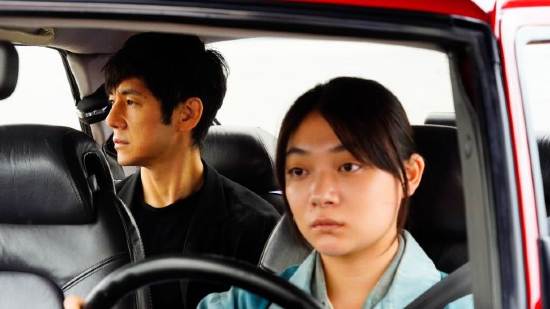
The melodic rotating faces of tire rims and cassette reels keep the time in Drive My Car, Japanese director Ryusuke Hamaguchi’s languorous adaptation of Haruki Murakami’s short story of the same name. The film’s meticulous commitment to unhurried emotional introspection might appear to be an overindulgence when considering its three-hour runtime, yet Hamaguchi and co-writer Takamasa Oe gracefully unfurl Murakami’s original story into a melancholy meditation of pain and performance that remains ever-enthralling. Renowned theater actor-turned-director Kafuku (Hidetoshi Nishijima) and his screenwriter wife Oto (Reika Kirishima) have what seems like a perfect relationship. Apart from sharing considerable marital bliss, they stimulate each other intellectually and sexually—oftentimes simultaneously. Oto will regularly weave narrative webs aloud while mid-coitus with Kafuku, reaching climaxes in literal and figurative senses. Despite the mutual adoration, both harbor a damning secret: Oto sustains a string of lovers as she hops around on productions, while Kafuku silently uncovers his wife’s infidelity without confronting her. Both maintain the facade of a remarkably happy couple that have been together for over 20 years, yet internally struggle with the emotional toll of concealing the extramarital affairs. The situation is only brought to a head years later, after Oto sustains a mortal injury and Kafuku covertly recognizes one of Oto’s past lovers at an audition for his forthcoming multilingual production of Chekhov’s Uncle Vanya. Simultaneously consumed by jealousy and intrigue, Kafuku casts his wife’s much-younger former paramour Takatsuki (Masaki Okada) in the titular role. The loneliness inherent in living through guilt-ridden grief is perhaps the most palpable aspect of Hamaguchi’s latest drawn-out feature. However, it is also the open embracing of this desolation that eventually yields the most tender and subtly exuberant results. It is through communal mourning—for lives (and lovers) shared or for the unknowable misfortunes of others—that ultimately binds us as human beings.—Natalia Keogan
When Sir Gawain departs Camelot, he rides past a scene of desolation. A once-prosperous forest stripped of its lush greenery by human hands, only splintered wood and dust remain. Through his journey, Gawain (Dev Patel) is greeted by similar, if not entirely equal imagery, constantly evocative of mankind’s awkward, unwanted presence within the natural world. One year prior, the Green Knight (Ralph Ineson) approached King Arthur (Sean Harris) and his Knights of the Round Table, conjured up by Gawain’s mother, Morgan Le Fay (Sarita Choudhury), seeking a participant for his Christmas Game. Should one of Arthur’s knights land a blow against him, the knight shall receive his mighty axe, but must seek him out exactly one year later to receive an equal blow in return. When Gawain, reluctant to accept though eager to bring honor to his name, agrees to the Green Knight’s terms, the humanoid creature only drops his axe and lowers his head to reveal an oaken neck, offering it to Gawain freely. Naturally, Gawain succeeds, but at what cost? The Green Knight retrieves his head and rides off into the night. Gawain understands he cannot do the same. Foliage sprouts in the stone cracks on the hall floor where the Green Knight’s blood has been spilt. David Lowery’s The Green Knight is a modern reckoning with a medieval fable. It’s a haunting, confounding, surprisingly erotic fantasy epic; a confrontation between man and nature, nature and religion, man and himself. Adapted from the anonymously authored Arthurian poem Sir Gawain and the Green Knight, Lowery’s austere yet spellbinding take on the simple 14th century legend evokes the same questions as the original work, interrogating the cost of one’s life for the sake of one’s honor when there is only certainty that they will die. “Greatness? Why is goodness not enough?” pleads Esel (Alicia Vikander), Gawain’s lover, a sex worker, whom he holds at arm’s length. But the film and Gawain’s quest carry a message that stretches far beyond the fantastical world of King Arthur, one about humanity’s inherent frailty in the face of far-reaching environmental destruction and what gods they have foolishly chosen in place of nature. Obscurities are what anchor The Green Knight as Lowery leans into the ambiguity that defines the original text and replaces it with his own equally mystifying visual interpretations. By blending his abstract sensibilities seen in 2017’s A Ghost Story with the grand fantasy of his live-action Pete’s Dragon, Lowery has crafted a breathtaking, titillating adaptation of folklore with a denouement that carries real-world weight.—Brianna Zigler

